From watching a majestic lioness chasing a zebra across the Serengeti to witnessing a baby elephant frolicking in a watering hole, my experiences in Tanzania have been some of the most incredible and thought-provoking of my life.
If, like me, you love the natural world and observing incredible wild animals in their natural habitats, then I have no doubts that you’re going to fall in love with the country too!
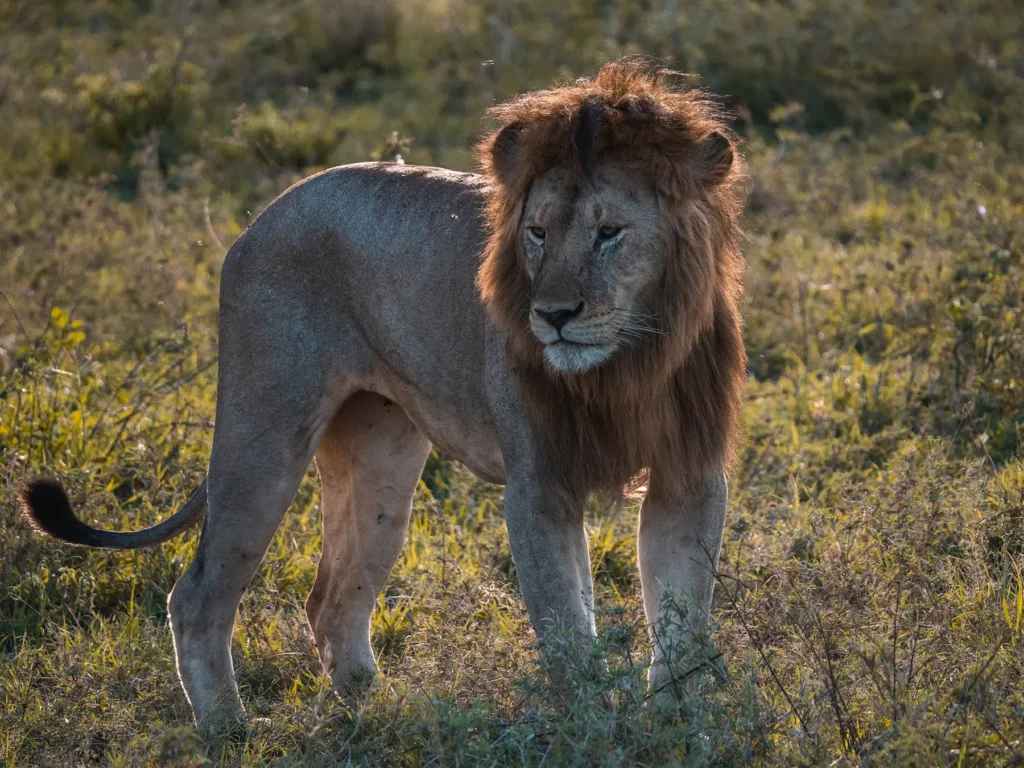
Tanzania has a reputation as being one of the greatest safari destination on earth. Boasting the vast and awe-inspiring Serengeti National Park, all of the Big Five, over 500 species of birds and 120 unique tribes, it’s not hard to see how the country has earned its enviable reputation.
With so much to see, you might be wondering if 5 days will cut it? Whilst you can easily fill out a 7-10 day Tanzania safari itinerary, 5 days will give you the opportunity to experience the very best of Tanzania including the world famous Serengeti National Park.
A 3 day safari itinerary is also possible (especially if you have the budget for a fly-in safari to save time). However, I would strongly recommend a 5 day itinerary (or more) as this will allow you to visit three of the best parks in Tanzania.
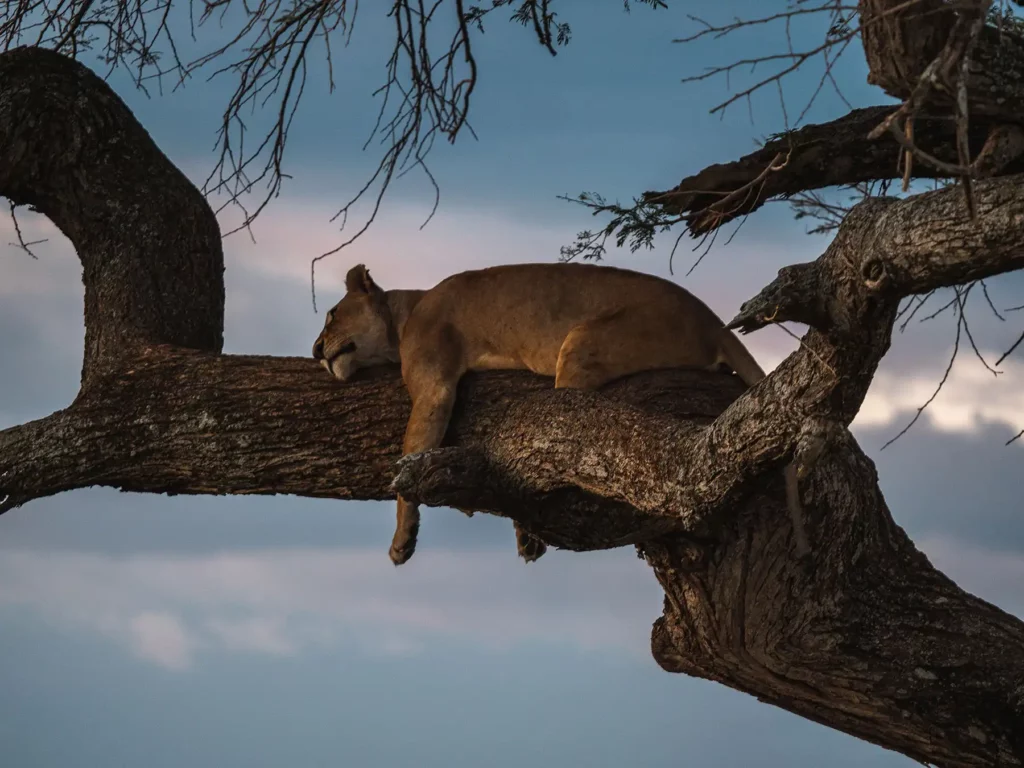
In this article I’m going to walk you through all six of my ultimate 5 day Tanzania safari itineraries. I’ll also give you an idea of Tanzania safari costs and how to find and book the best safari tour company for each itinerary option.
On top of all that, I’ll provide guidance on the best time to visit Tanzania for each itinerary and share tips and tricks including how to avoid some of the mistakes I made such as a terrifying night-time taxi ride.
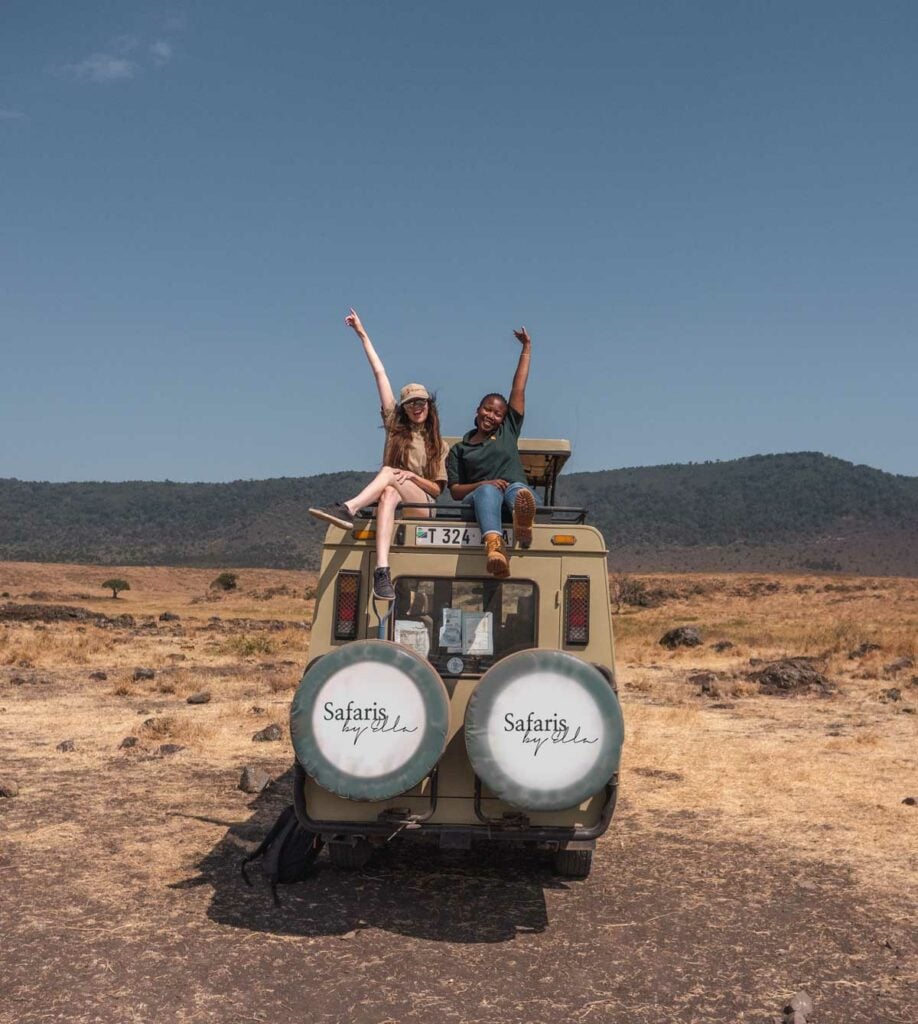
Plan Your Safari Adventure
Save time and ensure an incredible experience from the local safari companies I use to organise my own trips.
I’m here to make booking your perfect safari quick, easy and risk-free. It takes less than 1 minute to fill out the form and in under 48 hours you will receive multiple, no-obligation proposals from my favourite local tour operators with glowing online reviews.
In This Guide
- Six Unique 5 Day Tanzania Itineraries
- 5 Day Northern Circuit Highlights Itinerary
- 5 Day Great Migration Wildebeest River Crossing Safari Itinerary
- 5 Day Great Migration Wildebeest Calving & Other Baby Animals Safari Itinerary
- 5 Day Budget Safari Itinerary
- 5 Day Luxury Fly-in Safari & Beach Itinerary
- 5 Day Cultural Tour Including Hadzabe Bushmen Itinerary
- Is 5 Days Enough in Tanzania?
- How to Book a 5 Day Safari in Tanzania?
- How Much Does a 5 Day Tanzania Safari Cost?
- Tanzania Safari Tips & Tricks – Avoiding my Mistakes
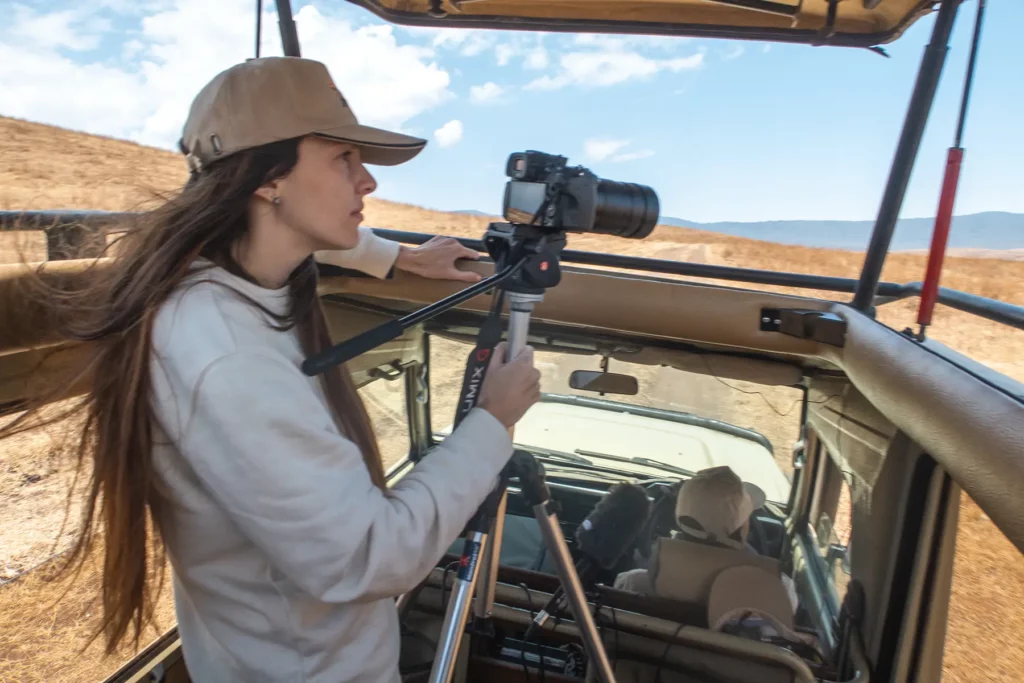
Six different 5 Day Tanzania Safari Itineraries
I’ve detailed six of my favourite 5 day Tanzania Itineraries below.
I’ve focused on Tanzania’s Northern parks for my 5 day itineraries as the Northern circuit contains some of the best and most popular parks in Tanzania. The southern parks are drastically more spaced out and would require much longer than 5 days.
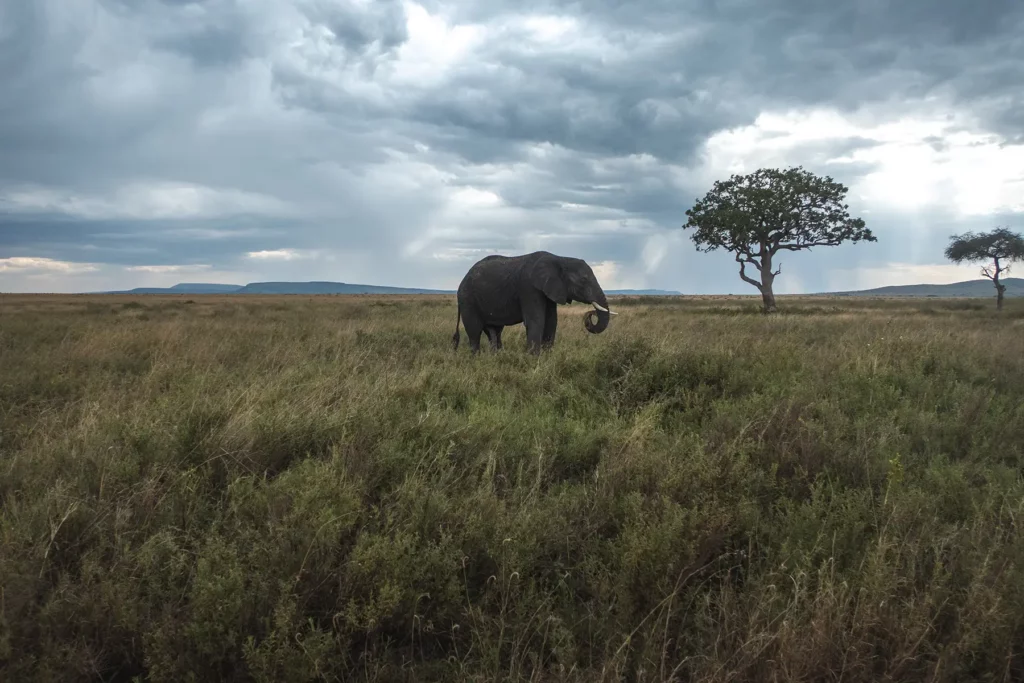
Option 1
5 Day Northern Circuit Highlights Itinerary
This is the most popular of the 5 day safari itineraries as it takes you to all the highlights of Tanzania’s Northern Circuit and to three of country’s best parks including the world-famous Serengeti, the magical Ngorongoro Crater and Tarangire National Park with it’s huge African elephant herds.
A variation of this itinerary is going to Lake Manyara National Park. However, I didn’t include it as the wildlife sightings are not quite as predictable in Lake Manyara at the moment due extreme rainfall over the last few years affecting the lake height.
If it’s your first time in Tanzania then you can’t go wrong with this classic 5 day safari itinerary. It’s also the fixed itinerary for most group camping safaris, so despite going to some expensive parks it can still work well if you’re on a budget.
On the flip side if you’ve looking for a luxury private safari you can upgrade this itinerary with a balloon safari in central Serengeti or alternatively you might want to consider my 5 day wildebeest migration river crossing or 5 day wildebeest calving itineraries as well.
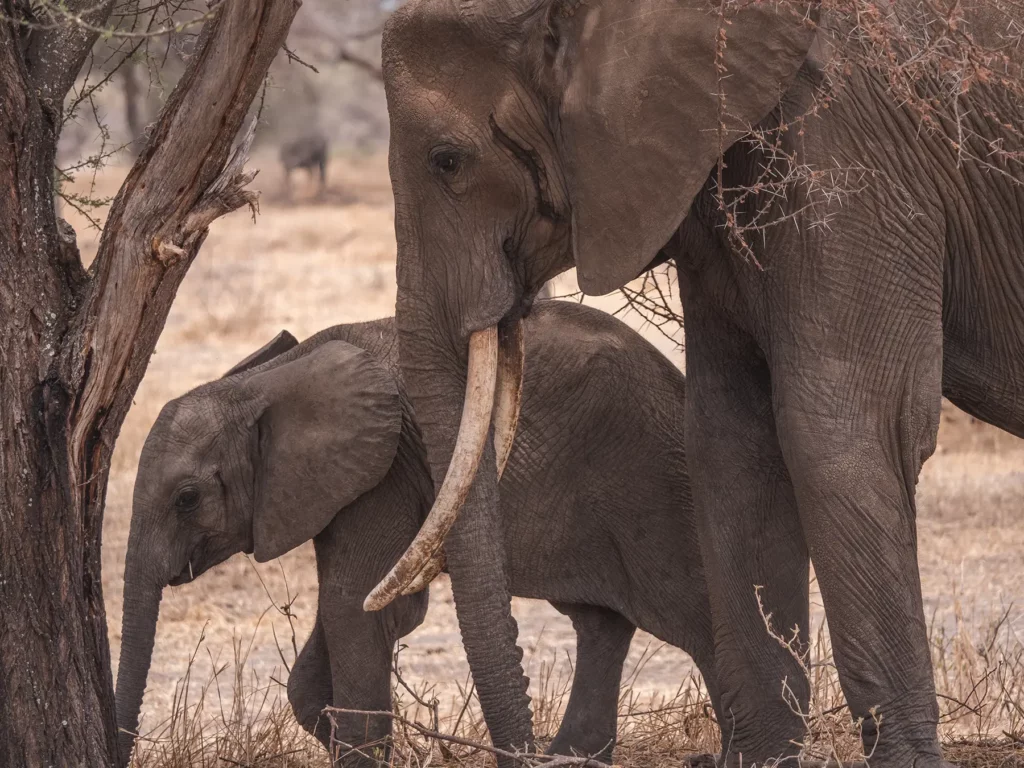
Quick Facts
- Average driving time per day: 3.3 hours.
- Best times of year: Long dry season from June to October or the short dry season from January to February.
Itinerary Map for 5 Day Northern Circuit Highlights
Itinerary starts and ends in Arusha.

Day By Day Breakdown for the 5 Day Northern Circuit Highlights Itinerary
Day 1: Tarangire – total drive time 5.5 hrs
Your journey starts in Arusha, the gateway to Tanzania’s world-famous Northern Safari Circuit. It takes around 3 hours to drive west from Arusha to Tarangire National Park’s Northern Gate.
Activities for Your Day in Tarangire Nation Park
You’ll go on a full day game drive around the park. You also have the option of a walking safari if you want an even more intimate experience.
About Tarangire Nation Park
Tarangire is the sixth biggest park in Tanzania at 2,850 km². The park’s name comes from the Tarangire River which spans across the park and provides a water source for its many inhabitants. The park is famous for its huge heard of majestic African elephants which can reach over 5,000 in total during the peak of the migration from July to October.
Tips for visiting Tarangire Nation Park
The best time to visit Tarangire is in the dry season when the migratory herds are present.
There are two fantastic lunch spots in Tarangire but there’s no catering so bring your own hot or cold lunch. If you are visiting with a tour operator, they will typically provide this for you.
My Personal Experience in Tarangire Nation Park
In my opinion, Tarangire is severely underrated. As soon as I entered the park, I found myself surrounded by wildlife. It’s one of the most wildlife-dense places that I’ve ever been! I absolutely loved watching the majestic African elephant herds in Tarangire – it’s one of the best places in Tanzania to see them. A highlight for me was watching a family of elephants drinking at one of Tarangire’s watering holes. A baby elephant rolled joyfully in the water, a sight that warmed my heart. The park fees are also around 50% of the Serengeti making it a great value park to visit.
You can watch a video of my Tarangire safari experience on Youtube.
Where to Spend the Night
Whilst it’s possible to spend the night in the Tarangire, it’s usually wise to drive for 2 hours to Karatu – a small bustling town and the gateway to the Ngorongoro Highlands. Karatu is closer to the Serengeti so saves on driving the next day and it’s also better value vs in-park accommodation.
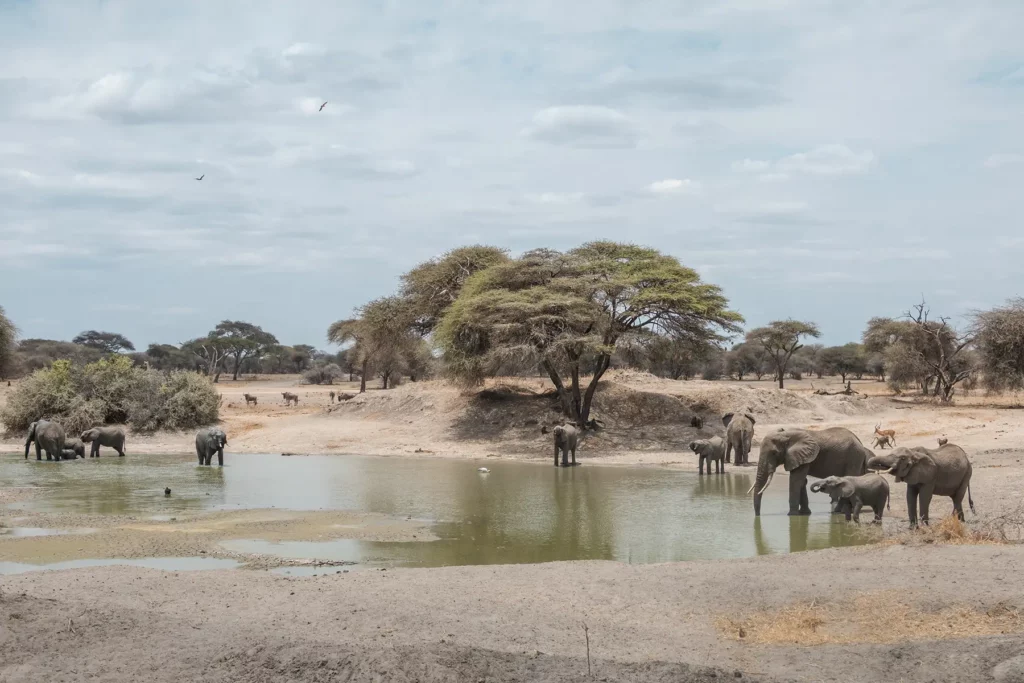
Days 2 – 4: Seronera (Central Serengeti) – total drive time 7 hrs
You now begin your epic 4 hour journey from Karatu to Seronera (Central Serengeti). After around 2 hours you’ll reach the Serengeti entrance gates and restrooms before the real adventure begins.
You’ll spend the rest of day 2, all of day 3 and the morning of day 4 in the Serengeti.
Activities for Your Day in Seronera (Central Serengeti)
Other than embarking on game drives through the open plains of the Serengeti, the other key activity that you can enjoy is a balloon safari. Serengeti balloon safaris (normally around $450-550 per person) take place before sunrise and give you a bird’s eye view of the savannah. They may be expensive but the experiences is honestly a once-in-a-lifetime. Where else can you float effortlessly above the wilds of Africa and perhaps even witness the Great Wildebeest Migration from the air?
Walking safaris and night game drives aren’t permitted in the Serengeti.
About Seronera (Central Serengeti)
The Serengeti which means ‘endless plains’ in the local Maasai language is quite possibly the greatest safari destination on earth. Home to all of the Big Five and spanning 30,000 km², The Serengeti National Park is awe inspiring in every way. To give you an idea of the scale, the Serengeti is 20x the size of Kenya’s Masai Mara National Reserve which sits on the other side of the Mara River in Northern Serengeti.
You’re in for a treat – central Serengeti has one of the highest densities of predators of any national park. Lions, cheetahs, leopards and hyenas can all be found here. The Serengeti is also one of the few places in the world where you can catch a glimpse of tree-climbing lions!
Tips for visiting Seronera (Central Serengeti)
The best time to visit the Serengeti is during the dry season from June to October or January and February.
If you’re visiting during mid-July to September or mid-October to mid-November, you also have the option to view the river crossing where millions of wildebeests cross the crocodile-infested Mara river. It’s a 4 hour drive each way (or 1 hour flight) to northern Serengeti, where the Mara River can be found. Going there and back in one day is ambitious and honestly not recommended as the wildebeest can spend hours milling on the banks of the river, unsure whether to cross.
Not truly contemplating how the odds were stacked against me, I took the chance and headed up north to try to catch a glimpse of the Mara river crossing. Luck was definitely on my side as I managed to catch the river crossing in full swing. In fact I actually saw two river crossings! However, I must emphasise that I was very, very lucky as often you have to wait for 4 hours or more to see the river crossing. Sometimes the wildebeest don’t cross at all!
If you want to see the river crossing, it’s better to extend your trip an extra day or two and spend a couple of days in northern Serengeti or alternatively follow my 5 day Serengeti Itinerary below.
If you’re visiting between January to March I’d recommend visiting southern Serengeti to view the wildebeest calving and related big cat activity.
During May to July, you may wish to drive to Tanzania’s Western Corridor (west Serengeti) to watch the Grumeti River crossing. Some say it’s as spectacular as the Mara river crossing but is nowhere near as popular so you won’t be competing with lots of vehicles to get front-row seats.
My Personal Experience in Seronera (Central Serengeti)
Driving into the Serengeti was in itself a magical experience – the vast planes of the south seem to go on forever, blending with the horizon-line. It almost felt otherworldly and brought back memories of my Namibia road trip.
Nothing could have prepared me for how abundant the wildlife is in the Serengeti. Sure, I knew of it’s fantastic reputation but seeing it for itself is something else. I was amazed by the numbers of lions I spotted. It actually got to the point where we would drive past lion sightings as we had seen so many.
One of the highlights of my time in central Serengeti was watching a pregnant lioness stalk a zebra. I felt like I had been transported into a nature documentary and held my breath as she ran full-pelt through the scrubland, the zebra only just managing to escape her grasp.
Another magical moment was spotting my first ever wild leopard. Leopards are perhaps the hardest of the Big Five to spot. In one single afternoon in the Serengeti, I managed to spot not one but three leopards: a mother and cub and a solitary female.
Watching two cheetahs gorge themselves on a freshly-caught wildebeest was another moment that I will never forget.
You’re probably getting the point now. The Serengeti is heaven for wildlife lovers.
You can watch a video of my Serengeti Safari experience on Youtube
Where to Spend the Night
You’ll spend the night of the second and third day in the Serengeti. On the morning of the fourth day, you’ll enjoy a sunrise safari in the Serengeti as you head towards the mystical Ngorongoro Crater. Once you reach the gates of the Serengeti, it takes around 2 hours to reach the Ngorongoro Conservation area where you’ll spend the night, usually on the rim of the crater.
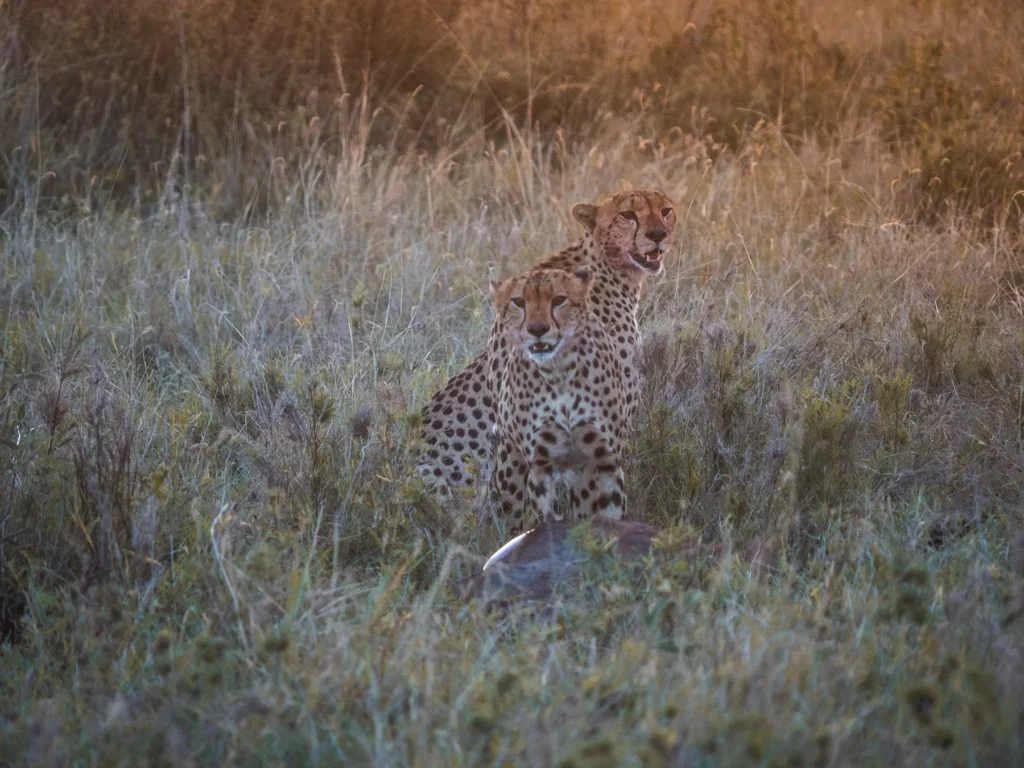
Day 5: Ngorongoro Crater & Maasai Tribe (total drive time 4 hrs)
First thing in the morning you’ll drive along the crater rim through dense swathes of forest before beginning your epic 2,000 meter decent into the Ngorongoro Crater. The Ngorongoro Crater is unlike anywhere else on earth – towering crater walls surrounding a barren plane. To me it felt like I had entered into a lost world filled with a stunning array of wildlife and habitats.
Activities for Your Day in Ngorongoro Crater
You’ll spend the morning on a game drive in the crater followed by lunch on the banks of Lake Magadi, a large alkaline lake which is home to flamingos and hippos.
In the afternoon you’ll you’ll ascend the crater and visit a Maasai village to see their famous jumping dance and learn more about their unique culture. You’ll also go on a guided walk with the Maasai around the rim of the crater where you’ll be rewarded with spectacular views and lear about the Maasai’s deep connection to the crater.
About Ngorongoro Crater
Part of the wider Ngorongoro Conservation Area which is a UNESCO world heritage site, the crater is a massive caldera formed millions of years ago by the collapse of a volcano.
The crater was named by the Maasai Tribe after the sound produced by the cowbell (ngoro ngoro) as their crows walked around the crater.
It is the only conservation in Tanzania which protects wildlife whilst also allowing the Maasai to live in the area too, although no one is allowed to live within the crater itself.
Tips for visiting Ngorongoro Crater
I’d recommend an early start when visiting the crater as it avoids the crowds and gives you the best chance of spotting one of the 30 rare black rhinos which call the crater home. The rhinos usually congregate together around sunrise before splitting off in search of food.
You can’t beat having a pre-prepared hot lunch on the banks of Lake Magadi inside the crater. Your safari company can arrange this. You’ll have views of flocks of lesser flamingos and the odd prehistoric looking marabou stalk.
As most of the wildlife stays in the crater all year round, the best time to visit Ngorongoro Crater is pretty much all year round. However, the very best times are the short dry period from January and February to see baby animals and the long dry period from June to October when grass on the crater floor is shorter so it’s easier to spot wildlife.
My Personal Experience in Ngorongoro Crater
Ngorongoro Crater was one of the highlights of my trip to Tanzania. As we drove along the crater rim, we found ourselves engulfed by mist which created an eerie yet electric atmosphere.
My first view of the crater itself is one that will stay with me for the rest of my life. I felt like I was within Jurassic Park, entering a prehistoric lost world.
There are very few trees on the crater floor which makes it very easy to spot wildlife. As soon as I entered the crater I spotted a lone hyena, a group of buffalos and then found myself surrounded by herds of wildebeest and zebras.
The highlight of my Ngorongoro safari was spotting a family of servals, one of Africa’s smaller cat species. Servals are rare to see which made the sighting of a family of servals hunting rodents in the grass all the more special.
You can watch a video of my Ngorongoro Crater safari experience on YouTube.
Where to Spend the Night
After the day’s activities you’ll return back to Arusha for the night.
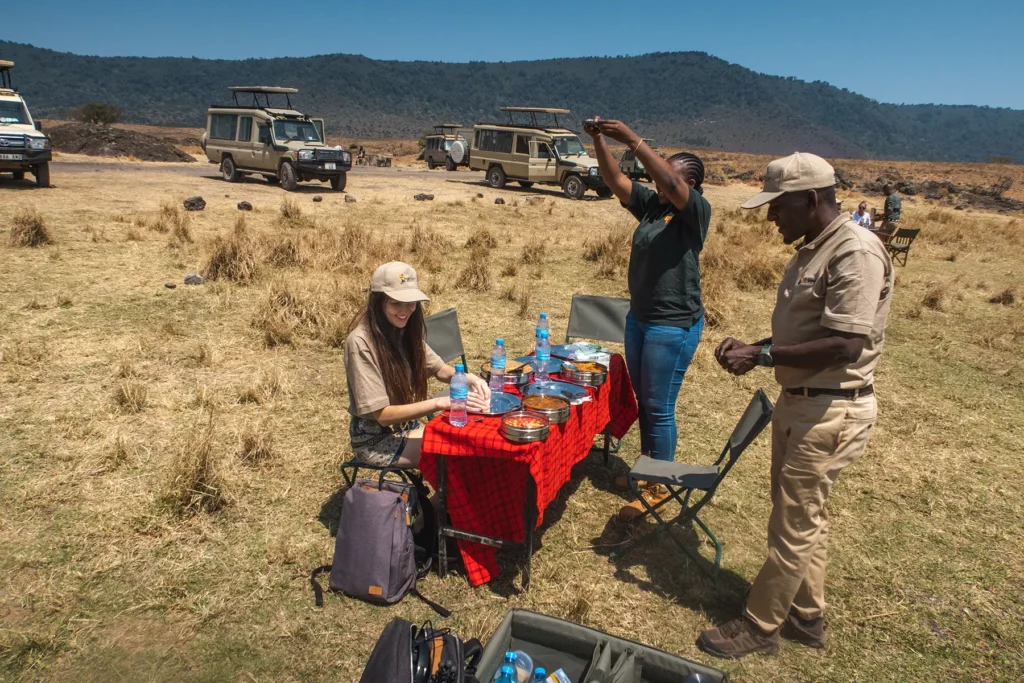
Costs
For this 5 day itinerary, full board Tanzania safari costs for private safaris start at around $280 per person per day for 4 people and $330 for two people. Prices assume working with a small local safari company and will vary depending on the level of accommodation chosen and number of people sharing the safari truck.
For budget and mid-range safaris, park fees make up the biggest proportion of the total safari costs.
In Tanzania it’s usual practice for the safari companies to organise everything and give you an ‘all inclusive price’. However, I wanted to give you a quick example of how the pricing breaks down:
Ngorongoro Crater is the most expensive of Tanzania’s safari parks and entry fees for one safari truck plus 2 adults at the time of writing are $613 + 18% Tanzania tax = $723.34. Then you have around $350 per day for the private safari truck and your driver / guide, so that’s a running total of $536.5 per person for that particular day before adding accommodation and other costs.
Due to the high park fees, local tour companies don’t usually make much profit on the safaris – usually around 10% – 15% and much of this is offset against the special trade prices they receive for accommodation, so they end up working out very cost effective.
Recommended Booking Options For Your Northern Circuit Highlights Itinerary
Private Safari
Most popular & best experience – typical prices for this itinerary start from $280 per person per day.
Visit safarisbyella.com for free quotes from trustworthy local tour companies I use to book my own trips.
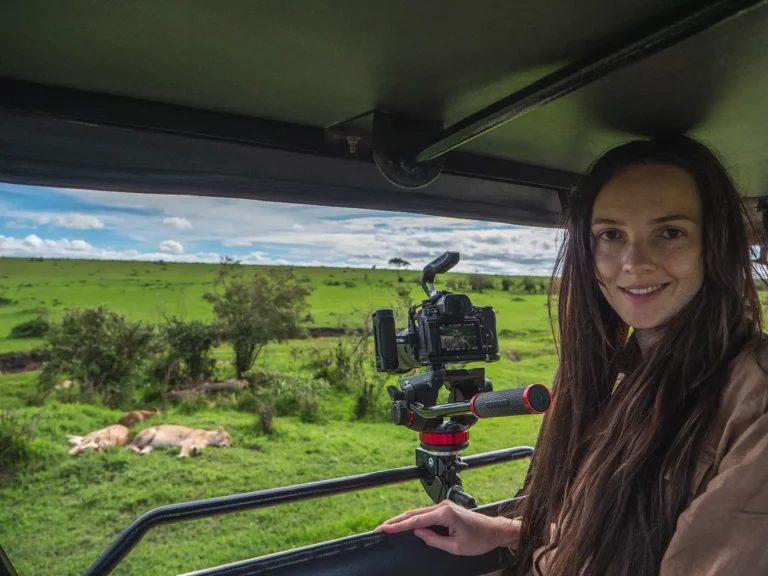
Group (Shared) Safari – Usually Camping
Good for budget or solo travellers – from $180 per person per day.
My recommended Tanzania tour operators only provide private safaris, however, I’ve listed the best and most similar group options for this itinerary, on SafariBookings below.
Click the link below to request quotes for the group safari options on the SafariBookings website.
5-Day Group Budget Camping Tour for the Northern Circuit Highlights Itinerary (Option 2)
View All My Recommended Group Options Following a Similar Itinerary
Jump back to the table of contents to select another 5 day itinerary to view or keep scrolling to read the next itinerary.
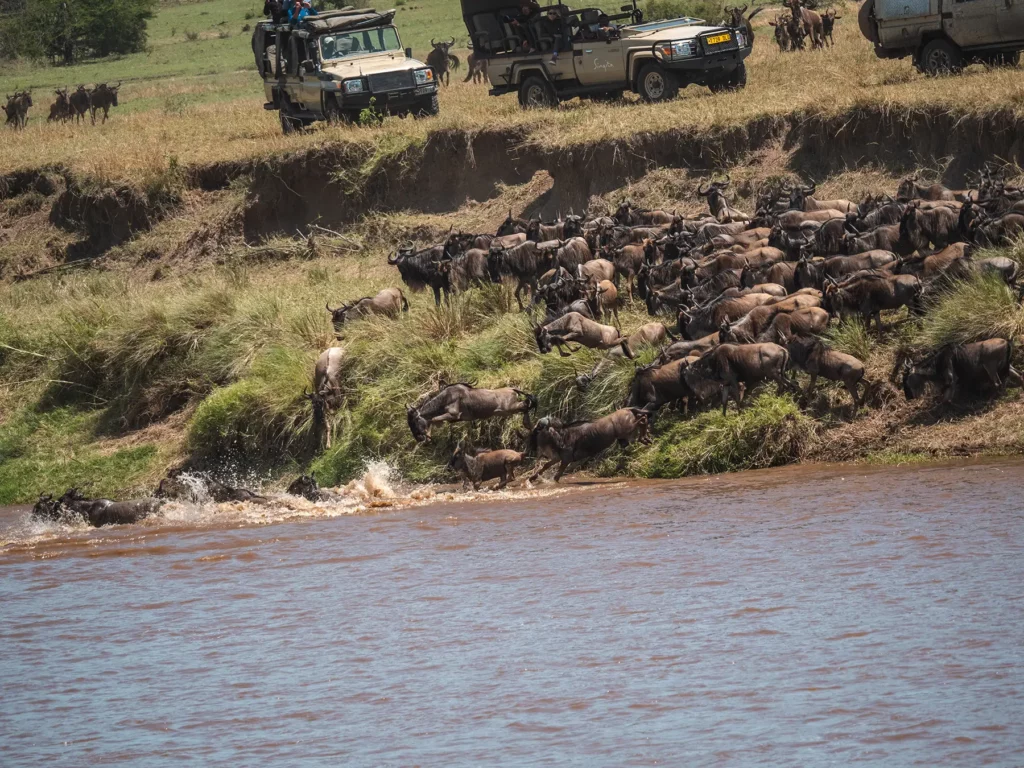
Option 2
Great Migration Wildebeest River Crossing Safari Itinerary
This 5 day itinerary gives you quite possibly the ultimate safari experience in just 5 days. You’ll be spending most of your time in arguably the best safari park in the world – the Serengeti.
However, prices will work out more expensive than the 3 park option above due to the inclusion of an internal flight and higher Serengeti park fees.
Your adventure begins with a flight on a small propeller plane from Arusha to northern Serengeti. Alternatively, it’s a 7-8 hour drive if you want to save on flight costs.
At the Serengeti National Park you’ll have a good chance of seeing all of the Big Five as well as the the Great Wildebeest Migration crossing the Mara River in northern Serengeti.
You’ll break up your drive back to Arusha at the end with a night in Ngorongoro Conservation area followed by a morning safari in the mystical Ngorongoro Crater. This is the best place to try to catch a glimpse of a black rhino.
Late May and early June marks the beginning of the Great Migration – one of the greatest wildlife spectacles on earth.
During the migration, millions of wildebeest and zebras journey from the southern plains to the northern Serengeti in search of fresh pastures.
The very pinnacle of the Great Migration is the Mara River crossing in northern Serengeti where up to thousands of wildebeest at a time cross the crocodile-infested Mara River.
This five day itinerary aims to give you the best chance possible of experiencing this once in a lifetime spectacle. If you want to see the river crossing, then you would need to visit mid-July to late September or in mid-October to mid-November when the wildebeests cross back again.
Dates vary depending on the variable timings of the rains each year – choosing a date towards the middle of the period would be the safest bet if you want to maximise your chances and seek the guidance of a professional safari company.
You can still experience the other incredible sights of the Great Migration outside of these dates such as the calving in January and February (see my 5 day wildebeest calving itinerary) or the Grumeti River crossing on Tanzania’s Western Corridor from may to July. However, you would adjust day 3 and 4 of the itinerary depending on the location of the migration at that time of year.
I’ve seen some versions of this itinerary which suggest you should drive to the Serengeti, visiting Ngorongoro Crater on your way and then fly home. The main drawback with that itinerary is that you will be entering Ngorongoro at midday, so have missed many wildlife sighting opportunities.
In my itinerary you fly out first to make sure you can visit the crater first thing in the morning as it avoids the crowds and gives you the best chance to see the black rhinos grouped together before they separate for the day.
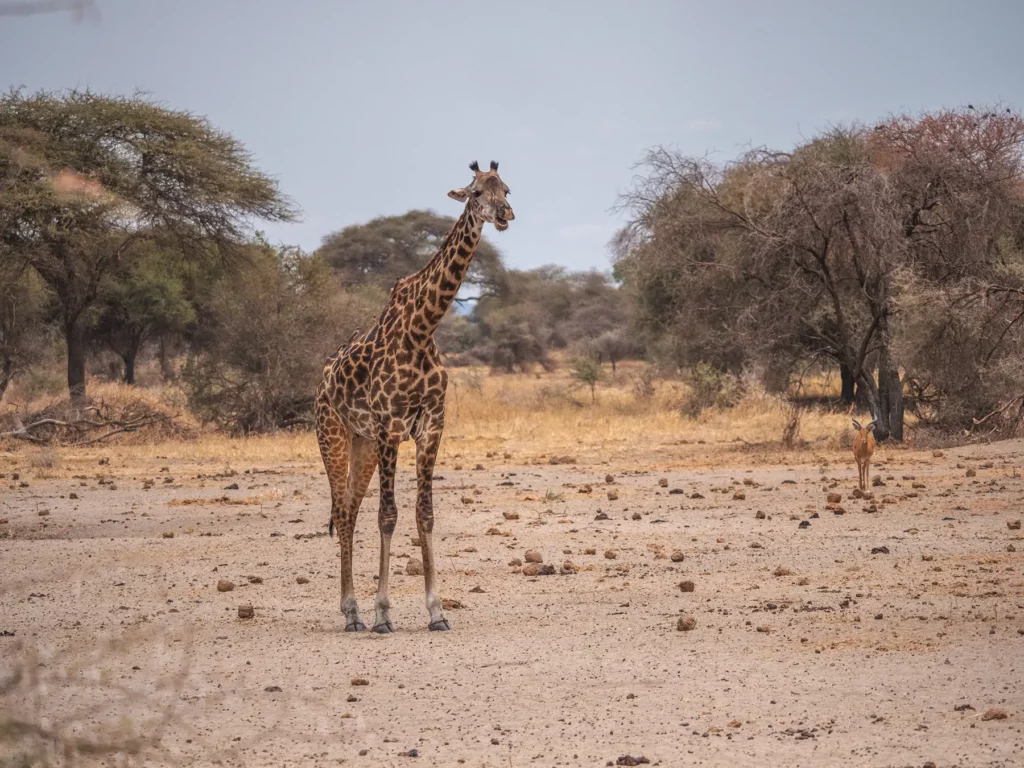
Quick Facts
- Average driving time per day: 1.4 hours
- Best times of year: For the Mid-July to late September or mid-October to mid-November*
- *Dates can vary according to the timing of the rains
Itinerary Map for Great Migration Wildebeest River Crossing Safari
Itinerary starts and ends in Arusha.
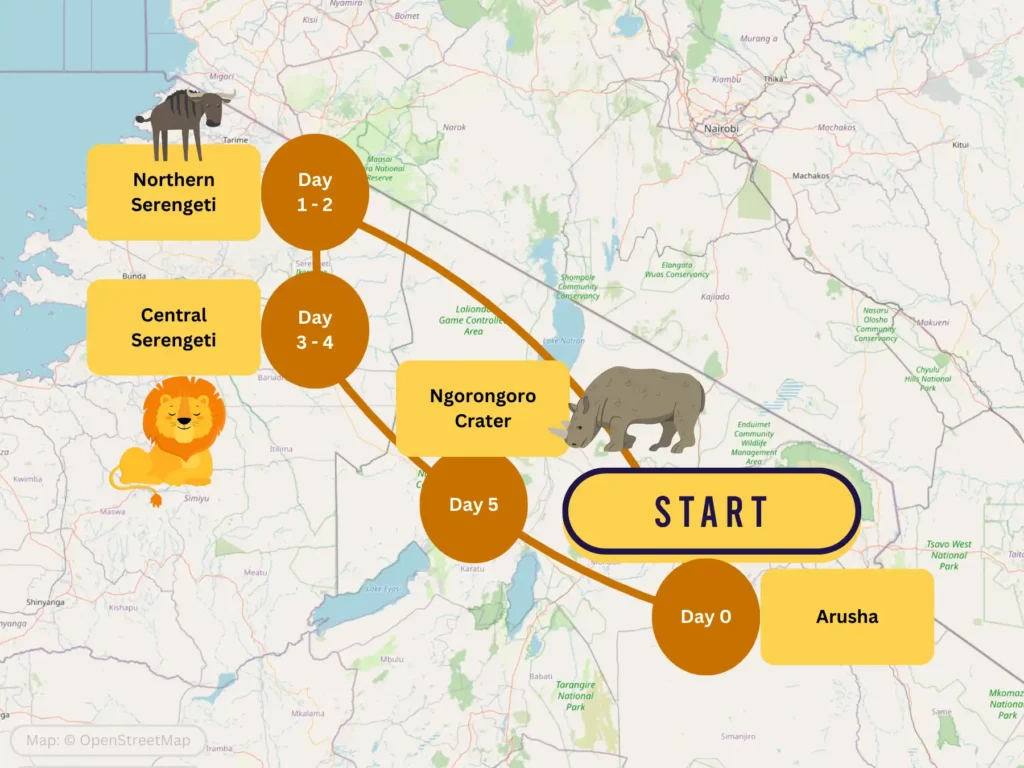
Day By Day Breakdown for the Great Migration Wildebeest River Crossing Safari Itinerary
Days 1 & 2: Kogatende – Northern Serengeti – total flight time: 1 hour OR drive time 8 hrs
Your journey starts in Arusha, the starting point for most of Tanzania’s northern circuit safaris. From here you’ll catch a small propeller plane which will take you directly to northen Serengeti. Flights normally cost around $350 per person and they give you the opportunity to see the vast Serengeti from the air.
If you’d prefer not to fly or would simply like to keep costs down, you can drive instead which takes 7-8 hours.
Depending on the time of year, you’ll adjust your destination in the Serengeti to see the Great Wildebeest Migration.
It’s worth noting these are rough dates as the timings of the rains can speed up or slow down the usual migration timeframes. A good safari company will be able to keep you updated on this to ensure you get the best experience.
For this Itinerary we’re going to assume you’re visiting around mid-July to late September or mid-October to mid-November and are keen to see the Mara river crossing.
Here are a few other variations of this itinerary if you’re going on different dates:
May to July: fly to western Serengeti to see the Grumeti River crossing.
January and February: Follow my 5 Day Great Migration Wildebeest Calving & Other Baby Animals Safari itinerary and fly to central Serengeti and then make your way south via car to see the Wildebeests calving in southern Serengeti and the Ngorongoro Conservation Area
Activities for Your Days in Kogatende – Northern Serengeti
Day 1: If you’ve flown, you’ll have plenty of time for a safari for the rest of the day.
Day 2: You’ll wake up for your first full day in the Serengeti, arguably the greatest safari destination on earth.
I’d recommend a balloon safari at sunrise as this will give you a bird’s eye view of the Great Migration. After the balloon safari, you’ll spend the rest of the day day on a game drive and will have the opportunity to witness the incredible Mara river crossing at close quarters.
About Kogatende – Northern Serengeti
The Serengeti which means ‘endless plains’, is home to all of the Big Five. The park covers 30,000 km² making it 20x the sizes of the adjoining Masai Mara
In the north, during the river crossing, thousands of wildebeests wait hesitantly on the banks of the crocodile-infested Mara river until eventually one of them takes the plunge and scrambles down the steep banks before launching itself into the river whilst the hungry crocodiles watch on. As herd animals, this prompts hundreds more wildebeests to follow, jumping into the water and swimming across the river whilst the crocodile patiently wait for any weak animals to exhaust themselves trying to scramble out on to the steep bank at the other side.
Tips for visiting Kogatende – Northern Serengeti
The best time to visit the Serengeti is during the long dry period from June to October to see as any animals as possible. Alternatively, if you want to see baby animals and related big cat activity, then January and February is a great option.
My Personal Experience in Kogatende – Northern Serengeti
When I visited the Mara River, I was lucky enough to see the wildebeests crossing almost immediately, although some people had been waiting 4 hours. My luck hadn’t run out yet and, shortly after the first crossing, my guide found another crossing taking place. It was here that we managed to witness a crocodile successfully hunt a young wildebeest calf.
You can watch a video of my Serengeti Mara River Crossing Safari on YouTube
Where to Spend the Night
You’ll spend night 1 & 2 in Kogatende – northern Serengeti. There are both tented and non-tented accommodation options available. I’d recommend staying in tented accommodation as you feel much closer to nature. Nothing is as magical as hearing a distant lion roaring as you lie in bed!
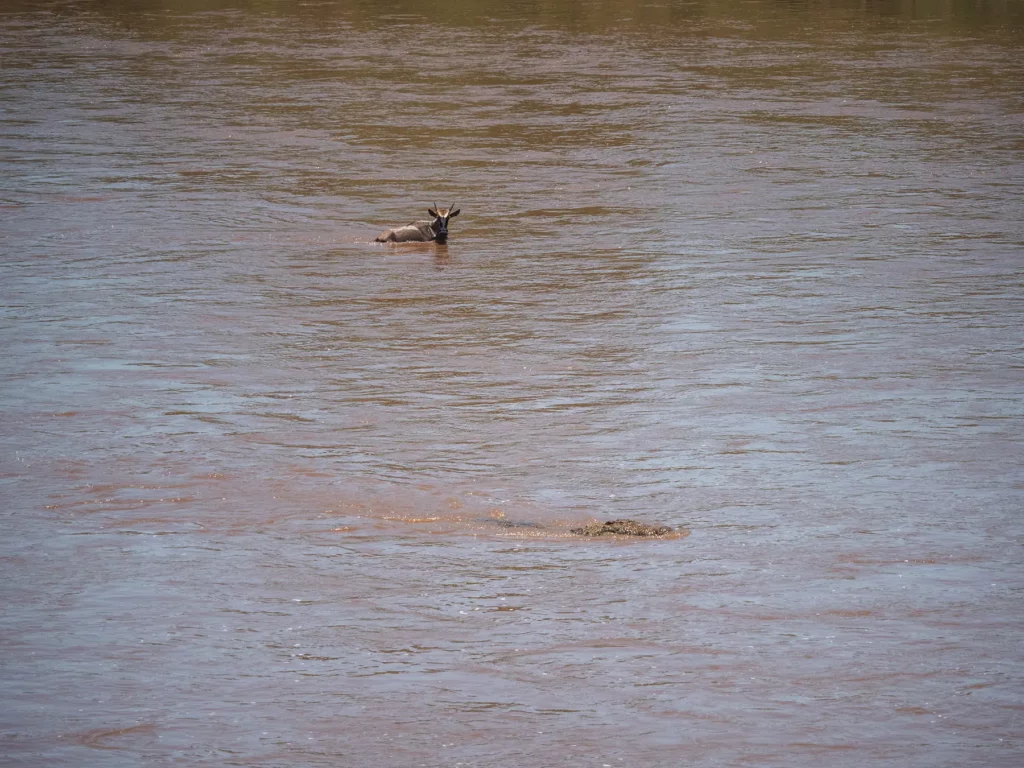
Days 3 & 4: Seronera – Central Serengeti – total drive time 3 hrs
On day three you’ll make your way down from the north to Seronera (central Serengeti) which will take a couple of hours. Your journey will double-up as a game drive and you’ll find yourself meandering down quiet tracks through the savannah, keeping a look-out for the Serengeti’s famous residents.
Day four is your last morning in the Serengeti and a great opportunity to enjoy a sunrise game drive.
Sunrise safaris are a great time to see predators hunting as its cooler compared to the day-time during which times predators usually laze around in the heat of the sun.
You’ll continue your safari, keeping a look out for the Big Five as the morning turns to afternoon.
After your safari, you will continue your drive south to the Ngorongoro Consveration Area.
From the gates of the Serengeti it takes a further 2 hours to reach the Ngorongoro Conservation area. Spending the night on the rim of the crater provides fantastic views.
Activities for Your Days in Seronera (Central Serengeti)
You’ll spend most of your time on game drives.
About Seronera (Central Serengeti)
Central Serengeti has one of the highest densities of predators including tree-climbing lions. It’s also one of the best places in Africa to see leopards.
Tips for visiting Seronera (Central Serengeti)
Early morning or late evening game drives are a great way to see big cats hunting. They prefer these times as it gets too hot in the day.
Keep an eye out for any tails hanging down from trees – this is often a tell tail sign of a tree-climbing lion or elusive leopard.
My Personal Experience in Seronera (Central Serengeti)
Spending a full day on safari in Seronera was one of the highlights of my entire time in Tanzania. Nothing gets me as excited as spotting big cats so imagine my delight when I managed to spot more lions than I can count, three leopards and three cheetahs within a 24 hour period in Seronera.
Other notable sightings included elephants galore, large herds of zebra, several families of giraffes and a couple of spritely warthogs.
You can watch a video of my Central Serengeti safari experience on YouTube.
Where to Spend the Night
You’ll spend night two in central Serengeti and night three on the rim of Ngorongoro Crater.
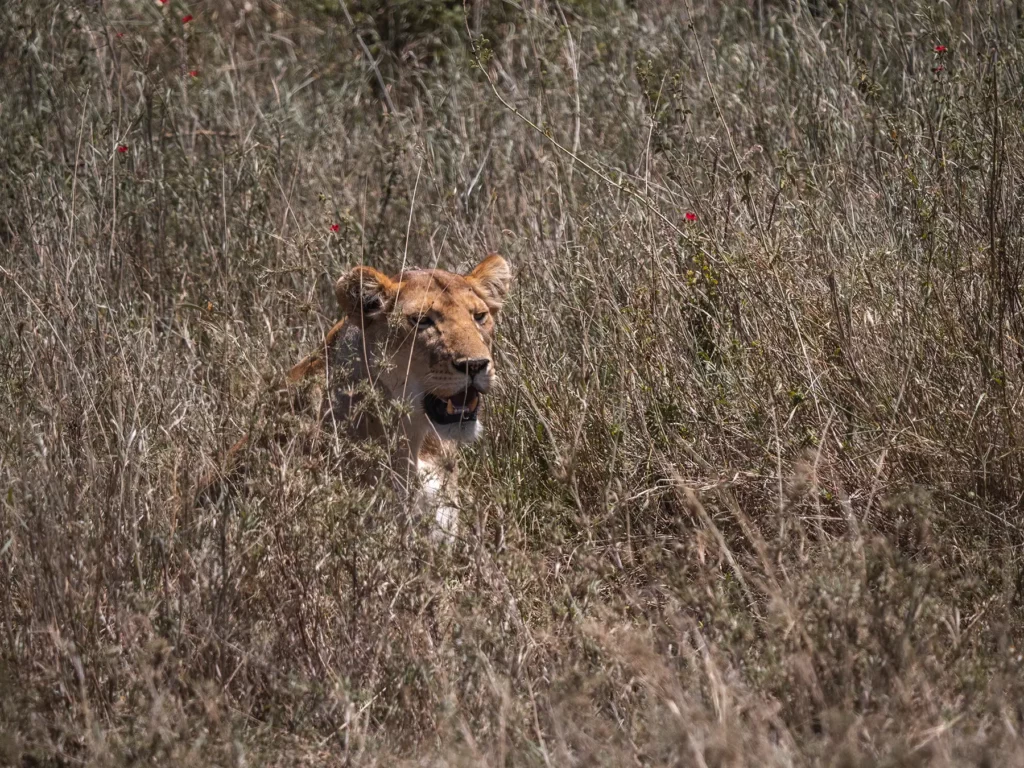
Day 5: Ngorongoro Crater & Maasai Tribe (total drive time 4 hrs)
In the morning you’ll embark on a 2,000 meter decent into the lost world of the Ngorongoro Crater. You’ll spend the bulk of the day within the crater before visiting a Maasai boma on your way back to Arusha.
Activities for Your Day in Ngorongoro Crater
Much of the day will be spent on a game-drive in the Ngorongoro Crater. Your safari will be broken-up by a picnic lunch on the banks of Lake Magadi.
After your safari you’ll visit a Maasai Boma on the rim of the crater where you’ll watch their traditional jumping dance and join them on a walk along the crater rim enjoying spectacular views and learning about their connection with the area. Finally, you’ll drive back to Arusha which takes around 4 hours.
About Ngorongoro Crater
Part of the UNESCO world heritage site of the Ngorongoro conservation area, the crater is a calera which was formed millions of years ago by the collapse of a volcano .
The Crater is one of the only places where you can see the black rhinos which are best spotted at sunrise or sunset.
Tips for visiting Ngorongoro Crater
I’d recommend asking your safari company to bring a packed lunch (often provided by your accommodation) so you can eat lunch in the crater on the banks of the Lake Magadi. It’s a wonderful experience to have lunch with wildlife all around you such as flocks of lesser flamingos and the odd prehistoric looking marabou stalk.
The best time to visit Ngorongoro Crater is during the short dry period from January and February to see baby animals or the long dry period from June to October when grass on the crater floor is shorter so it’s easier to spot wildlife. However, as most of the animals in the crater, don’t migrate, the park is great to visit year-round.
My Personal Experience in Ngorongoro Crater
I absolutely loved my time on safari in Ngorongoro Crater. Although I didn’t personally spot any rhinos, I still managed to sight three of the Big Five (lions, buffalos and elephants) on the crater floor. The landscape is like no where else on earth and is pretty much guaranteed to take your breath away.
You can watch a video of my Ngorongoro Crater safari experience on YouTube.
Where to Spend the Night
You’ll spend your last night in Arusha.
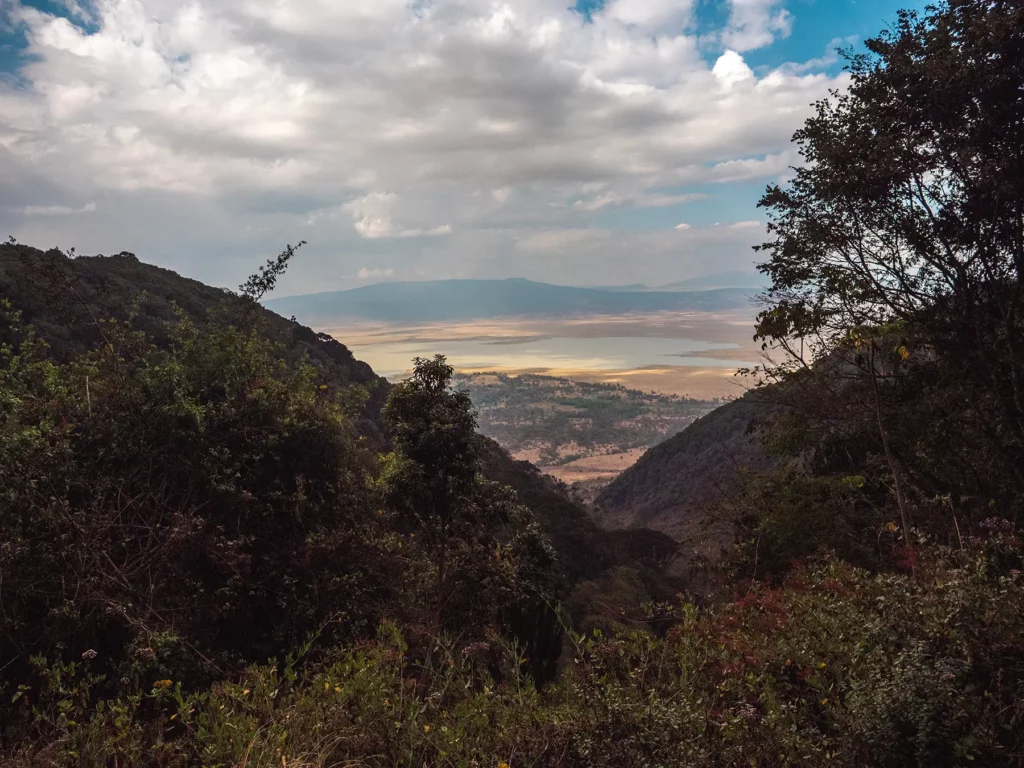
Costs
Whilst this itinerary will give you even more game viewing time compared to the first itinerary option, as well as incredible sightings, it will also be more expensive.
Compared to the first Itinerary, you are adding a flight to the Serengeti which is more expensive compared to driving. However it gives you more time on the Serengeti. It’s also worth noting that whilst flights are more expensive than driving, you will save the $80 fees per person to pass through the Ngorongoro Conservation area which would be paid when driving.
Compared to the first itinerary, you are also replacing a day in Tarangire with an extra day in the Serengeti which will increase the costs as Serengeti park fees are higher, plus you’ll be staying in the park overnight which required overnight fees (known as concession fees) to be paid.
For this 5 day itinerary, full board Tanzania safari costs for private safaris start at around $480 per person per day for 4 people and $520 for two people. Prices assume working with a small local safari company and will vary depending on the level of accommodation chosen and number of people sharing the safari truck.
Recommended Booking Options For Your Great Migration Wildebeest River Crossing Safari Itinerary
Private Safari
Most popular & best experience – typical prices for this itinerary start from $450 per person per day.
Visit safarisbyella.com for free quotes from trustworthy local tour companies I use to book my own trips.

Group (Shared) Safari – Usually Camping
Good for budget or solo travellers – from $210 per person per day.
My recommended Tanzania tour operators only provide private safaris, however, I’ve listed the best and most similar group options for this itinerary, on SafariBookings below.
Please note, it was only possible to find one 5-day group option for this itinerary as the group safaris typically drive instead of fly to save costs. I’ve listed a 6-day option too.
Click the link below to request quotes for the group safari options on the SafariBookings website.
5-Day Group Mara River Crossing Safari – travel via road (no internal flights)
6-Day Group Mara River Crossing Safari – travel via road (no internal flights).
View All My Recommended Group Options Following a Similar Itinerary
Jump back to the table of contents to select another 5 day itinerary to view or keep scrolling to read the next itinerary.

Option 3
5 Day Great Migration Wildebeest Calving & Other Baby Animals Safari Itinerary
The wildebeest calving season (part of the Great Migration) is where you will get to witness the largest concentration of large land animals in the wild and is something that you’ll remember for a lifetime.
Calving is the reason why the wildebeests risk their lives crossing the crocodile-infested river. They cross the river in order to position themselves near fresh pastures which give them the necessary energy for the demanding calving season as well as providing food for their newborns.
During this time, hundreds of thousands of wildebeests will give birth at a rate of 8,000 each day. It’s amazing to watch the baby wildebeests spring to their feet within minutes of being born, ready to run with the herd away from predators in just a few days.
With so many newborns around, it’s also one of the best times of year to see a successful predator hunt.
If you’ve visiting Tanzania in January, February or March and want to see the Great Migration, then this is the itinerary for you!
In March, tens of thousands of zebras and gazelles (who accompany the wildebeests on their journey) join the wildebeests in giving birth, relying on the safety of the numbers of the wildebeests to help protect their newborns.
I’ve seen some versions of this itinerary which suggest you should drive to the Serengeti, visiting Ngorongoro Crater on your way to the Serengeti and then flying home at the end. In my itinerary however, you fly out to the Serengeti first to make sure you can visit the Ngorongoro Crater first thing in the morning, as it avoids the crowds and gives you the best chance to see the black rhinos grouped together before they separate for the day.
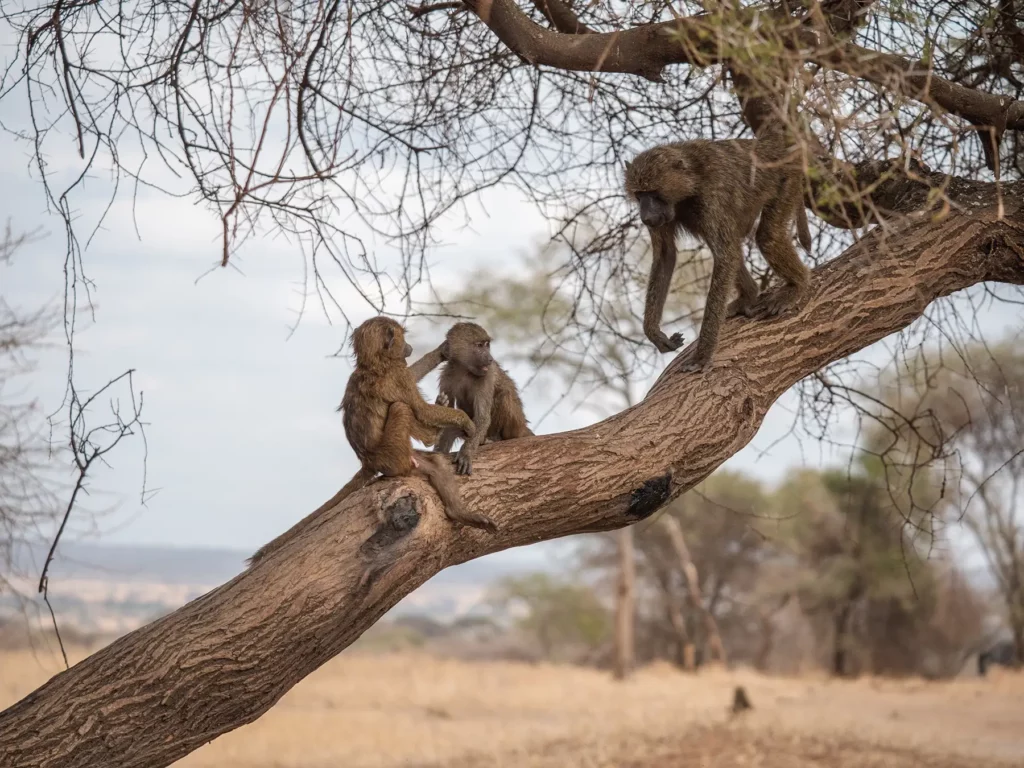
Quick Facts
- Average driving time per day:
- Best (only) times of year: January, February and March (February being the optimum month)
- As with all wildebeest seasons, the timings of the rains can bring things forward or push them back
Itinerary Map for 5 Day Wildebeest Calving Safari
Itinerary starts and ends in Arusha.

Day by Day Breakdown for the 5 Day Great Migration Wildebeest Calving & Other Baby Animals Safari Itinerary
Days 1 – 4: Ndutu – Southern Serengeti (Total flight time: 1 hour OR drive time 6 hrs)
You’ll start in the bustling city of Arusha, known as the gateway to Tanzania’s Northern Safari Circuit. From here you’ll catch a small scheduled propeller plane which will take you directly to the Ndutu Airstrip in South East Serengeti. Flights normally cost around $350 per person and give you the opportunity to see the vast Serengeti from the air as well as save 6 hours driving time.
If you’d prefer not to fly or to keep costs down, you can drive which takes around 6 hours.
There are a number of lodge options but the best for seeing the calving are the mobile tented camps which move around following in the migration. These provide large tents with proper beds and ensuite bathrooms.
If you’ve flown, you’ll have plenty of time for a safari for the rest of day 1.
On day 2 you’ll wake up for your first full day in the greatest safari destination on earth, about to see one of the most amazing wildlife spectacles in Africa.
Activities for Your Days in Ndutu – Southern Serengeti
Your guide will take you on safari in search of the migrating wildebeest herds which usually start calving around January. The pregnant wildebeests give birth and by February there are around 8,000 baby wildebeests being birthed every single day into March.
You will also see tens of thousands of zebras and gazelles who have accompanied the wildebeests on their migration, ready to give birth alongside the wildebeests, as they know their babies will find protection from any onlooking predators from within the vast number of wildebeests.
The huge quantities of young and inexperienced babies does not go unnoticed by the Serengeti’s high density of hungry predators. Big cats including lions, cheetah, leopards as well as African wild dogs, spotted hyenas and black-backed jackals stalk the herds, looking for their opportunity to pounce.
The new born calves spring to their feet in minutes to maximise their chances of survival and within 3 days they are able to run to escape predators. In this interim period they are left vulnerable and must rely on the size of the herd and their mother to protect them.
Your chances of seeing a successful hunt are very high. Many predators also give birth at this time of year as they know there will be plenty of food for their own babies.
If you want to experience the Great Wildebeest Migration from the air then you can travel to central Serengeti (1 – 2 hours drive) for a balloon safari at sunrise the following morning. Alternatively you can stay in the Ndutu region for the full 3 days.
About Ndutu – Southern Serengeti
The Ndutu Region spanning 8,000 km², is part of Ngorongoro Conservation Area, a UNESCO world heritage site and stretches to the southern Serengeti.
The area is famous for its short and particularly nutrient-dense grass, which is one of the reason the wildebeests choose this location for their calving. The extra nutrients in the grass help to sustain the wildebeests and their young as well as the other migratory animals during the birthing season.
The calving season attracts large numbers of hungry predators to the area including lions, cheetahs, leopards, spotted hyenas and African wild dogs.
Fortunately for the wildebeests, the short grass plains makes it harder for predators to hide when stalking the wildebeests and their calves.
It is the only nature reserve in Tanzania which allows you to drive off road which means you can get great views of the action.
Tips for visiting Ndutu – Southern Serengeti
The best location for viewing the migratory herds is on the banks of Lake Ndutu on the eastern edge of Serengeti National Park. The lake attracts large herds of thirsty wildebeests, zebras and other animals.
Where to Spend the Night
You’ll spend nights 1, 2 and 3 in the Ndutu region – usually in a mobile camp which follows the location of the migration. However, there are also fixed location accommodation too slightly further away.
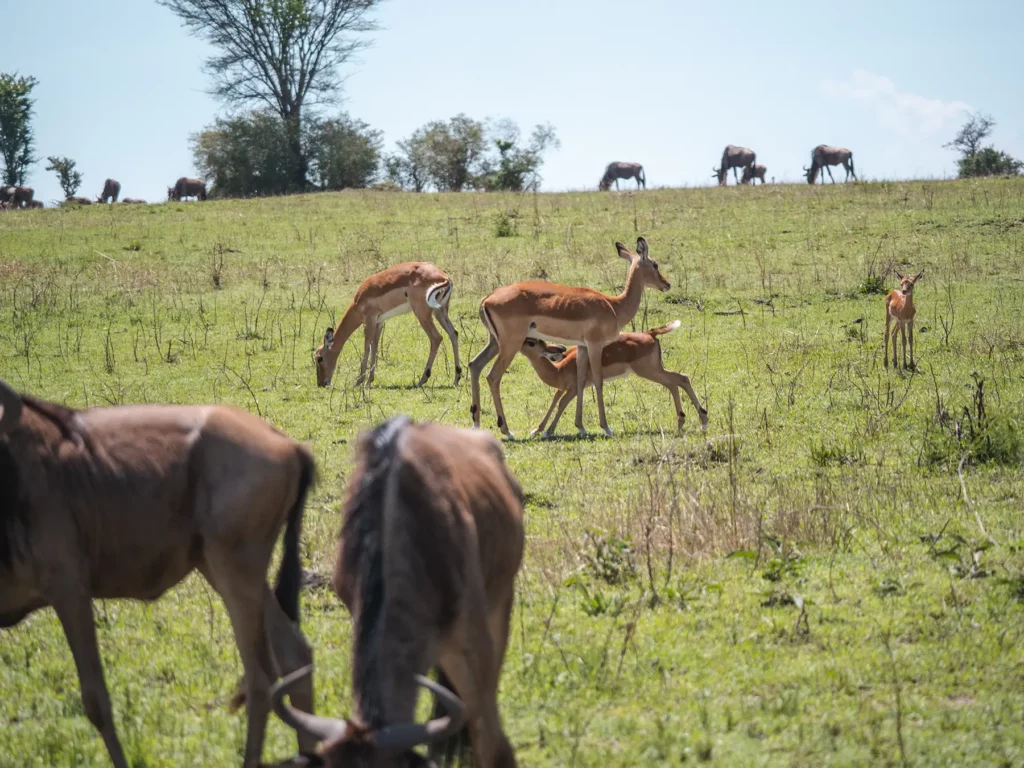
Days 4: Ndutu to Ngorongoro Highlands (total drive time 2 hrs)
Before you bid the Ndutu region of the Serengeti goodbye, there is time for a sunrise game drive through the southern Serengeti plains.
Early morning game drives are the perfect opportunity to see predators hunting as they are very active at this time due to the lower temperatures compared to later in the day.
After your nearly full-day game drive, it will then take 2 hours of driving to reach the Ngorongoro Crater rim.
You’ll spend the night on the rim of the crater which provides incredible views.
Activities for Your Day in Ngorongoro Crater
One the afternoon of day 4 you can visit a Maasai boma and go for a walking safari along the rim of the creator with Maasai guide.
Where to Spend the Night
You’ll spend the night on the Ngorongoro Crater rim with majestic views into the caldera.

Days 5: Ngorongoro Crater (total drive time 3 hrs)
This morning you will descend into the magnificent Ngorongoro Crater and go on a full-day game drive. There are two benefits to visiting the crater this early. Firstly, you’ll beat the crowds and secondly, it will give you the best chance to see the endangered black rhinos which gather together at sun rise before splitting off to look for food.
Activities for Your Day in Ngorongoro Crater
A full day game drive in Ngorongoro Crater, broken up by a picnic lunch overlooking Lake Magadi.
About Ngorongoro Crater
The crater which sits in the UNESCO world heritage site of the Ngorongoro conservation area is a giant caldera which was formed millions of years ago when a volcano collapsed.
Tips for visiting Ngorongoro Crater
Visit early and bring lunch with you – ideally ask your safari company to bring a hot lunch from your accommodation which you can eat on the banks of Lake Magadi. You’ll be surrounded by pink flamingos and the the views are fabulous.
The best time to visit Ngorongoro Crater is during the short dry period from January and February to see baby animals or the long dry period from June to October when grass on the crater floor is shorter so it’s easier to spot wildlife. However, as most of the animals in the crater, don’t migrate, the park is great to visit year-round.
My Personal Experience in Ngorongoro Crater
The 2,000 meter decent into the creator is quite magical. It’s like entering a lost world and filled me with awe and excitement for what was to come.
You can watch a video of my Ngorongoro Crater safari experience on YouTube.
Where to Spend the Night
After your safari you’ll ascend the crater and drive back to Arusha for the night.
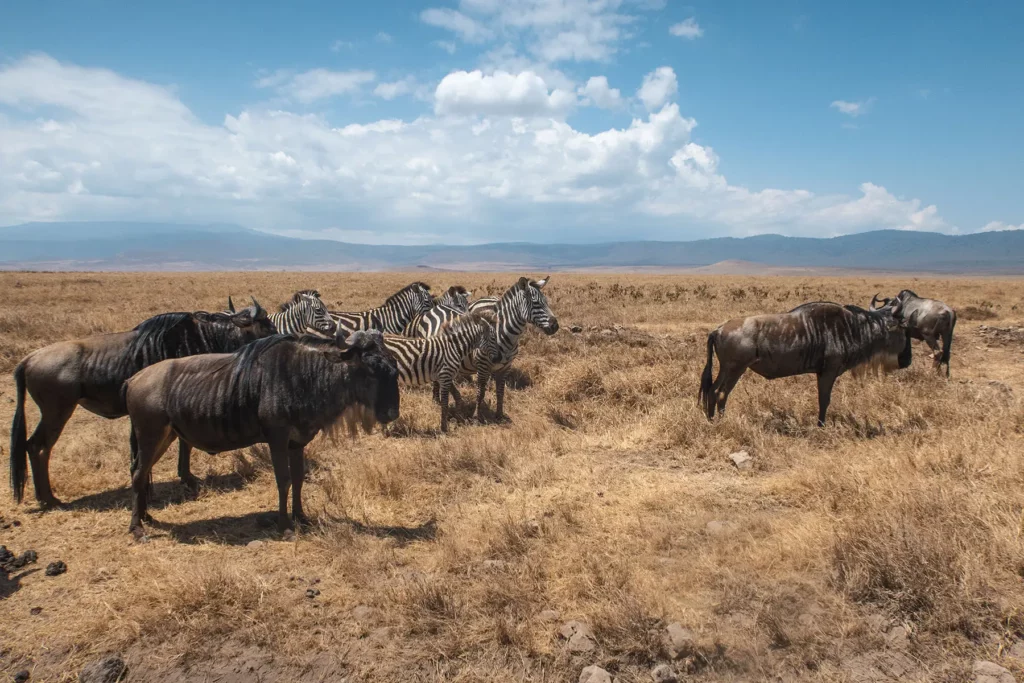
Costs
Seeing the Great Wildebeest Migration calving is a once in a lifetime experience and gives you one of the best opportunities to see successful predators hunts. However, compared to the first northern safari itinerary, this will be more expensive. This is due to the inclusion of a domestic flight to Ndutu as well as paying overnight fees to stay in the Ndutu region.
However the costs will be slightly lower than the river crossing itinerary above, as you’ll be traveling outside of peak season. Additionally, as Ndutu is actually within the Ngorongoro Conservation Area, you won’t have to pay a transit fee through Ngorongoro as you are already within the conservation area.
For this 5 day itinerary, full board Tanzania safari costs for private safaris start at around $400 per person per day for 4 people and $430 for two people. Prices assume working with a small local safari company and will vary depending on the level of accommodation chosen and number of people sharing the safari truck.
Recommended Booking Options For Your Great Migration Wildebeest Calving & Other Baby Animals Safari Itinerary
Private Safari
Most popular & best experience – typical prices for this itinerary start from $400 per person per day.
Visit safarisbyella.com for free quotes from trustworthy local tour companies I use to book my own trips.

Group (Shared) Safari – Usually Camping
Good for budget or solo travellers – from $374 per person per day.
My recommended Tanzania tour operators only provide private safaris, however, I’ve listed the best and most similar group options for this itinerary, on SafariBookings below.
This itinerary is more suited to a private tour as it's quite specialist. There is currently only an 8-day option available for group tours.
Click the link below to request quotes for the group safari options on the SafariBookings website.
8-Day Group Wildebeest Calving Safari – travel via road (no internal flights)
View All My Recommended Group Options Following a Similar Itinerary
Jump back to the table of contents to select another 5 day itinerary to view or keep scrolling to read the next itinerary.
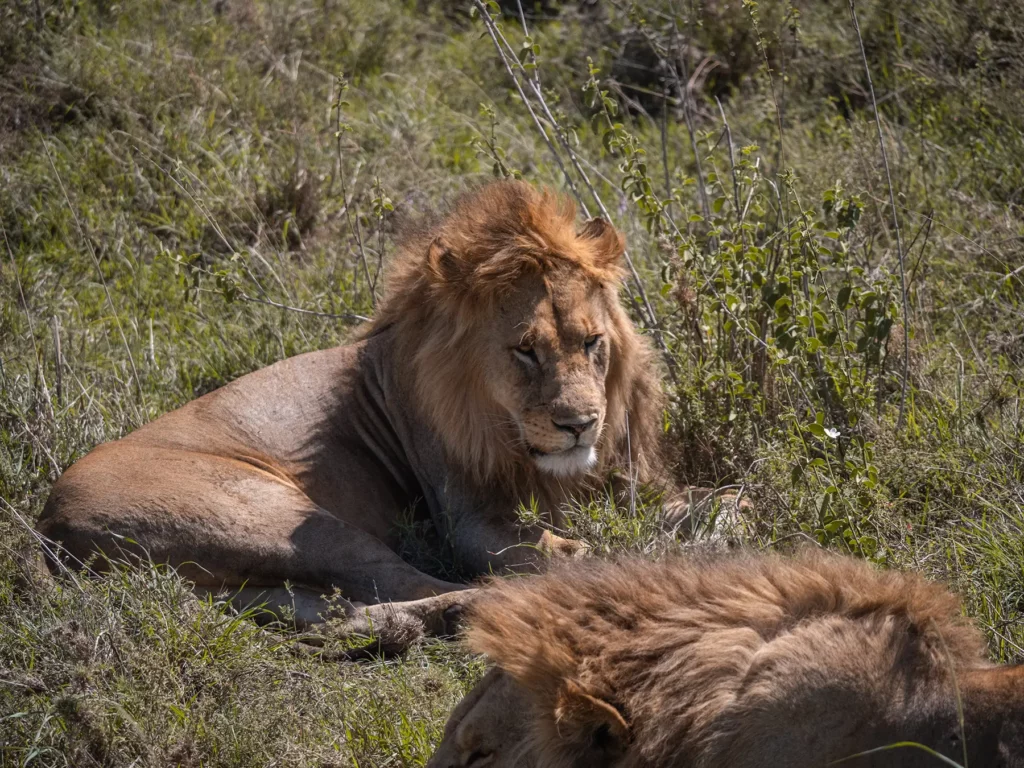
Option 4
5 Day Budget Safari Itinerary
The cheapest way to experience a Tanzania safari is usually by joining a group budget camping safari. You can view a list of my recommended group budget camping safaris here. However, there are some downsides to group safaris, which mean they are not the right choose for everyone on a budget:
- The itinerary is fixed, giving no flexibility .
- They run at scheduled times and for a fixed number of days – usually 3 or 6 days.
- You are sharing the safari truck with a number of people who may have different priorities on what to see and how long to spend at each sighting.
- Without the ability to easily move positions in the vehicle at a sighting, you may be stuck with a poor view of a great sighting.
- You can’t control how loud the other people in the group are which could scare animals away
- As group safaris are usually aimed at the budget market, they are no frills and sometimes the campsites are poorly maintained.
- The more experienced guides are usually allocated to private safaris leaving the inexperienced guides for group budget packages.
If you’re on a tight budget but you want to avoid the downsides of group safaris by booking a private safari instead, I have created the below itinerary. This itinerary for a private budget safari is lower cost than the others in this article, taking you to fantastic and sometimes lesser-know parks with lower park fees.
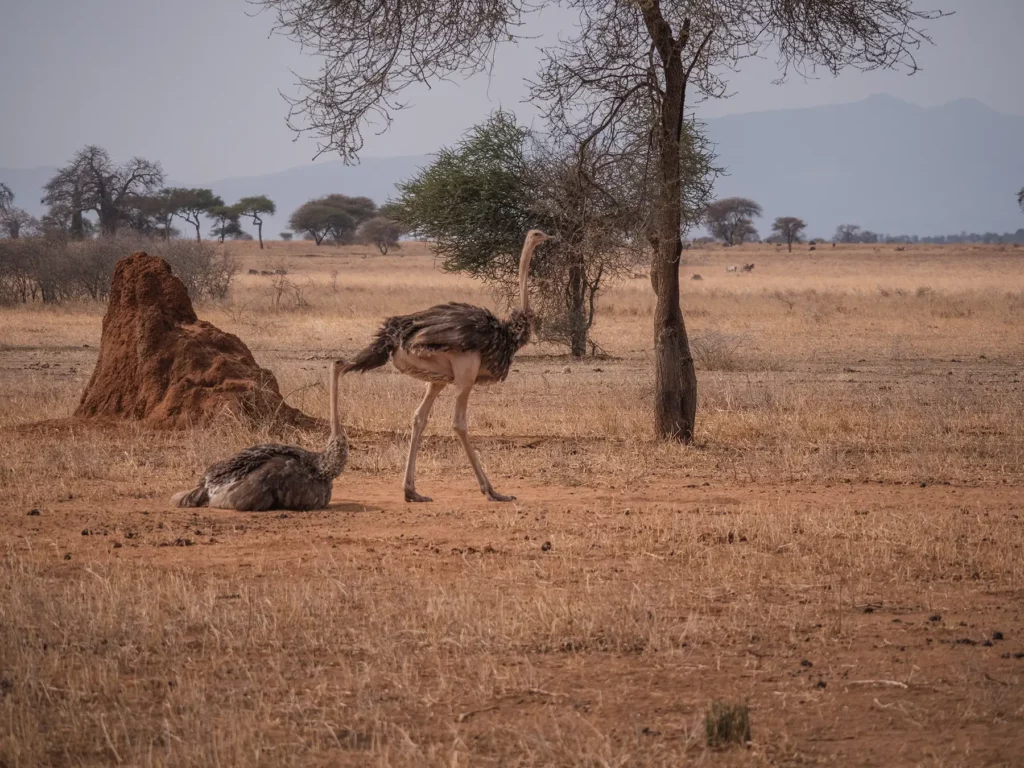
Quick Facts
- Average driving time per day: 3.8 hours
- Best times of year: Long dry season from June to October or the short dry season from January to February.
Itinerary Map for 5 Day Budget Safari
Itinerary starts and ends in Arusha.
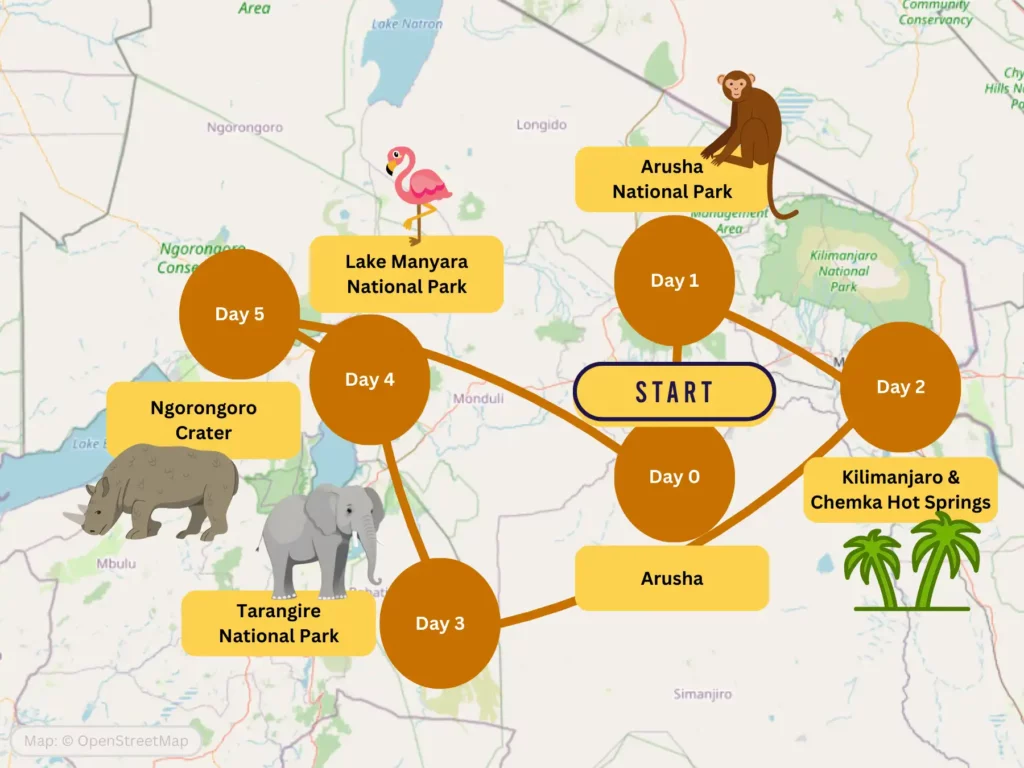
Day By Day Breakdown for the 5 Day Budget Safari Itinerary
Day 1: Arusha National park (Total drive time: 3 hrs)
Day 1 of the 5 Day Budget Safari Itinerary starts in Arusha. Although most safaris start in Arusha, known as the gateway to the northern circuit, most people don’t realise there is a hidden safari gem in Arusha itself. Located in the foothills of Mount Meru, Tanzania’s second highest peak, is the mysterious Arusha National Park.
As it’s lesser known, the park fees are much less than many of the other national parks. However, don’t let the lower park fees fool you – this park came highly recommended by one of my favourite Tanzanian safari guides.
Activities for Your Day in Arusha National Park
The park offers you the opportunity to spend a day on a walking safaris, game drives or even enjoy a spot of canoeing. I would personally recommend taking advantage of the opportunity to go on a walking safari as this isn’t always possible in some of the other national parks (although the government is gradually allowing them in more places, such as Tarangire where you’ll be visiting tomorrow).
About Arusha National Park
The park covers 552 km² and boasts the largest population of giraffes in the world. It’s one of the few places to see the Maasai giraffe and the reticulated giraffe in the same location.
Due to the varied ecosystems which include lush rainforests, savannahs, acacia woodlands and alpine vegetation on the higher parks of Mount Muru, the park incorporates some fascinating species of animals which can’t been seen in other Northern Circuit parks, such as the colobus and blue monkeys.
The park has its own mini version of the famous Ngorongoro Crater which is called Ngurdoto Crater and houses buffalos and elephants which you can explore on a game drive.
The Serengeti Ndogu (know as little Serengeti) and the forests including Tululusia Hill, a former looking dating back to Tanzania’s tribal wars with incredible 360 degree views, are both great destinations for a walking safari
Small Momella Lake is the perfect location for a canoeing safari. This picturesque lake has shallow waters and offers game viewing as animals are drawn to the shores of the lake to drink.
Tips for Visiting Arusha National Park
One of the things I loved about Arusha National park was that I was able to see all three distinct parts of the park within the day.
Whilst the park has a lot to offer, I’d recommend visiting it at the start of your safari as once you’ve been to some of the other parks in this itinerary, the bar gets set very high in terms of quantities of sightings.
Where to Spend the Night
For this budget safari itinerary, I’d recommend staying around Moshi as accommodation is good and it will minimise driving on day 2. I’d particularly recommend wearing mosquito repellent in Moshi as the heat and humidity does seem to attract them.
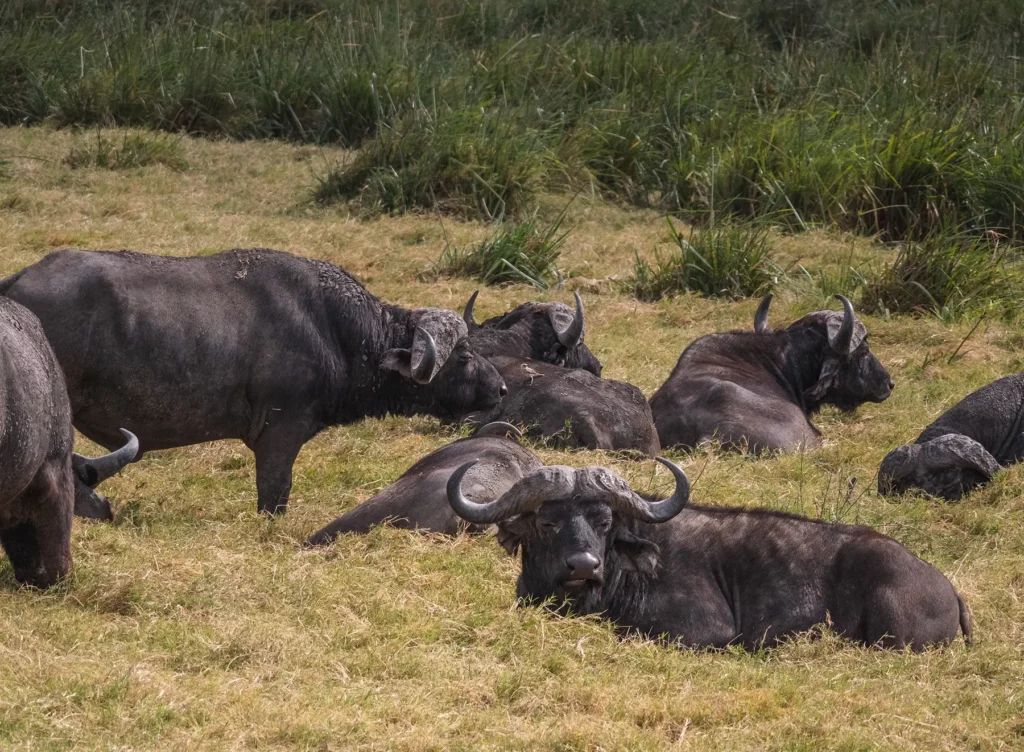
Day 2:
Kilimanjaro Coffee Tour, Materuni Waterfalls & Chemka Hot Springs (total drive time 5 hrs)
The cultural experiences I had I Tanzania were right up there with the safari / wildlife experiences. With over 150 unique tribes in Tanzania, spending one of your 5 days on cultural activities will really enhance your experience and help provider a deeper understanding of Tanzania. Taking a day off from safari also helps keep this a budget itinerary.
Today you’ll visit the famous Mount Kilimanjaro, meet the Chagga tribe who live on the slopes of the mountain, eat a traditional lunch and make some fresh coffee. Finally you’ll visit the paradise of Chemka Hot Springs where you can relax in the warm waters of the spring.
It’s around 45 minutes drive from Moshi to Materuni village. The village is located on the southern slopes of Kilimanjaro at an altitude of 1300 m above sea level.
Activities for Your Day in Kilimanjaro with the Chagga tribe & Chemka Hot Springs
From Materuni village, you can go a 45 minute walk to the thundering Materuni Waterfalls. Although the walk is fairly easy, I’d recommend some good walking boots, especially if it’s wet weather as it can get a little muddy. There is the option to drive closer to reduce the walk to 15 minutes.
The return leg of the circular walk takes you slightly uphill which and takes around 1 hour back to the village. Back at Materuni village, the Chagga tribe will show you the full hands-on process of preparing and roasting the coffee, which they have gown on the slopes of Kilimanjaro. Finally, you taste the delicious coffee and eat a traditional Chagga lunch as well as learning more about their way of life.
For the afternoon it’s a 1 – 2 hour drive down to the Chemka Hot Springs for a bout of afternoon relaxation.
The springs are around 10m deep at the their deepest and you can rent flotation devices. As well as access into the spring via steps, for the more adventurous travellers, there is a rope-swing into the water.
About Kilimanjaro, the Chaga tribe & Chemka Hot Springs
The Chagga (aka Chaga) are the third largest ethnic group in Tanzania and descended from immigrants of various Bantu tribes who inhabited the once forest-covered foothills of Kilimanjaro around 1,200 years ago.
The tribe are famous for their work ethic and members of the tribe work as porters carrying equipment up and down Kilimanjaro during expeditions. They also grow coffee, amongst other crops, on the fertile slopes of the mountain using organic fertilisation methods practiced and since 1920s. The coffee has been a large source of income, leading to them becoming one of the wealthiest tribes in Tanzania.
The Chemka Hot Springs are geothermal springs which were once worshipped by the Chagga people. The hot springs are made up of two lagoons connected by a narrow canal. At the bottom of the biggest lagoon is an underwater cave which produced bubbles; this is the source of the hot springs. The water originates from Kilimanjaro and is the reason why it’s warm.
The name Chemka means boiling in Swahili. Despite what the name would suggest, the hot springs are not hot. Instead they are pleasant at around 20°C.
There are two main types of fish that inhabit the springs – the red garra (which nibble the dead skin off your feet and the locals call massage fish) and the larger catfish.
Tips for visiting Kilimanjaro, the Chaga tribe & Chemka Hot Springs
At the Chemka Hot Springs there is a restaurant which serves fantastic local food.
If you can, bring your snorkel mask as it’s very pretty underwater.
There are some basic toilets but nowhere to lock your bags so I’d recommend leaving any valuables in the car if you’re planning to take a dip in the springs.
My Personal Experience in Kilimanjaro, the Chaga tribe & Chemka Hot Springs
I absolutely loved my afternoon at Chemka Hot Springs! Leaping into the water from the rope-swing was exhilarating and the temperature of the water was very soothing. I’ve honestly never seen water as clear as here – it glows a beautiful cyan colour under the dazzling sunlight.
You can watch a video of my Chemka Hot Springs experience on YouTube.
Where to Spend the Night
After your day of adventure, you’ll spend the night in Arusha.
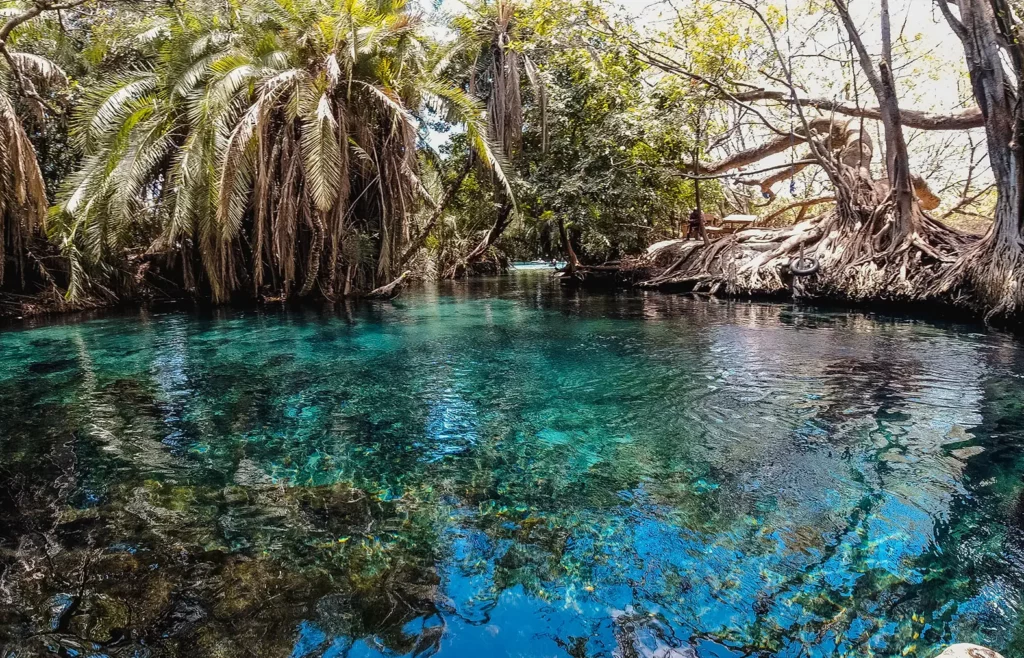
Day 3:
Tarangire National park (total drive time 6 hrs)
Where to Spend the Night
From Arusha it’s a 3 hour drive to Tarangire National Park’s northern gate.
Park fees for Tarangire are around 50% of the cost of the Serengeti making it great value without compromising on quality. Tarangire is one of my favourite national parks and one of the best places in the world to see African elephants in the wild. I loved watching numerous huge herds of majestic African elephants and their babies stroll around park.
Activities for Your Day in Tarangire National Park
You can spend your day on a game drive or alternatively the park has just started allowing walking safaris too which gives you an even more intimate experience.
About Tarangire National Park
Tanzania’s sixth biggest park at 2,850 km² park revolves around the Tarangire River, from which it gets its name. The river forms a ‘honey pot’ in the dry season, when thirsty animals migrate to the park and congregate around the river for water.
The most famous of these migratory inhabitants are the huge herds of African elephants, for which Tarangire is famous, and can reach up to 5,000 in number at the peak of the migration from July to October.
Tips for Visiting Tarangire National Park
The best time to visit Tarangire is in the dry season when the migratory herds are present.
To get the very best sightings of the park’s inhabitants, I’d recommend arriving as early as possible.
My Personal Experience in Tarangire
I was absolutely blown away by the sheer density of wildlife within Tarangire National Park. Not only did I feel surrounded by elephants, but giraffes, zebras, wildebeest, eland and so much more were in abundance. I even spotted a family of lions relaxing beneath an acacia tree.
You can watch a video of my Tarangire safari experience on Youtube.
Where to Spend the Night
Spend the night in Mto Wa Mbu, a town 3 hours outside of Tarangire, ready for an early start at Lake Manyara the following day.
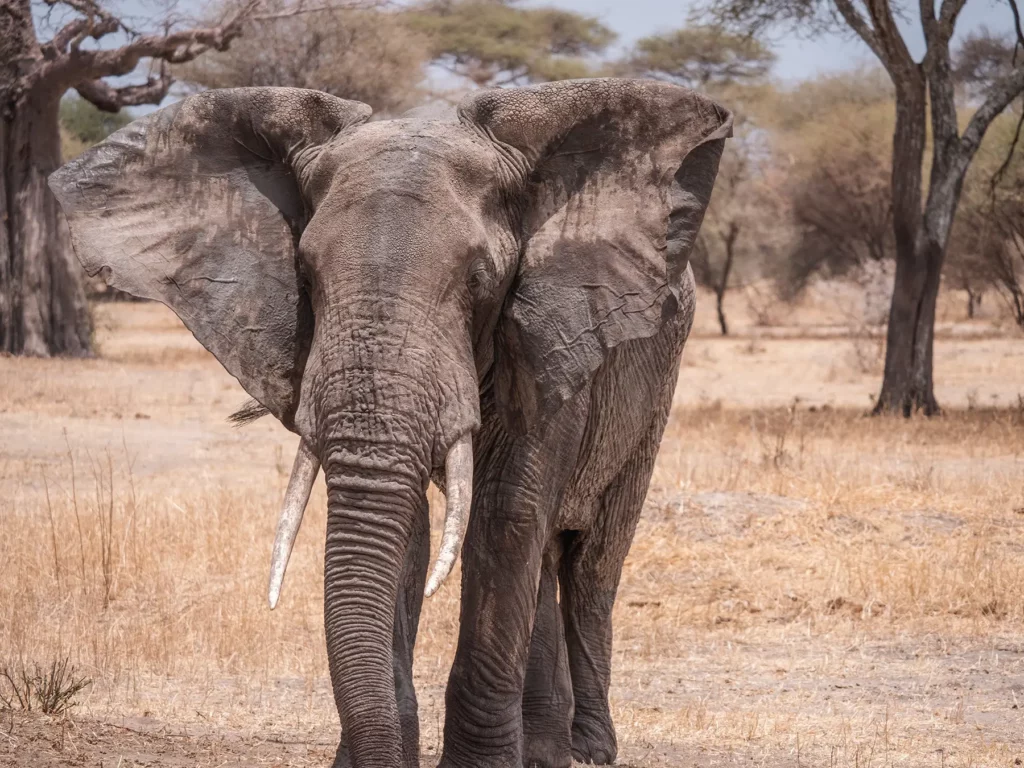
Lake Manyara National Park (total drive time 2.5 hrs)
Lake Manyara is another park which provides great value on park fees. The park is famous for its tree-climbing lions and huge flocks of pink flamingos as well as 250 other bird specifies.
It’s also a good place to see the effects of climate change as extreme weather has caused the lake to swallow up large swathes of the forest.
The drive to Lake Manyara National Park is only around 30 minutes.
Activities for Your Day in Lake Manyara National Park
It takes around 3-4 hours to game drive the whole of Lake Manyara National Park.
There is a 45 minute tree top canopy walk which allows you to view the park from a different perspective.
For the afternoon I’d recommend a canoe trip on the lake where you can see huge flocks of pelicans and pink flamingos and hear the sometimes not-so-distant sounds of hippos bellowing.
About lake Manyara
Lake Manyara National Park is one of the few places where you can spot tree-climbing lions on the acacia and sausage trees in the park. Covering a massive two thirds of the park is the large yet shallow lake.
The park covers an area of 325 km2 (125 mi2) including about 230 km2 (89 mi2) lake surface
The park was originally set up to protect the large herds of elephants who stroll around the park.
Tips for visiting Lake Manyara
The water levels need to be high enough to canoe so at the driest times of years it’s not always possible.
The park is a lot smaller than it used to be due to climate change which is marked by extreme weather. The lake has swallowed up a lot of the park due to excessive rainfall. In the lake you can see the remains of the park it swallowed in the form of the dead trees standing upright int he water.
You have the option to spend half the day in the park and the other half on a cultural tour in Mto Wa Mbu which you can see in my Youtube video linked below.
My Personal Experience in Lake Manyara
I had lots of fun canoeing on Lake Manyara in the company of local fishermen. There’s something so incredibly soothing about being out on the water, undisturbed by the rumbling of motors. I heard countless hippos, although they remained out of sight. Instead I saw some cheeky vervet monkeys on the banks of the lake as well as Maasai herders, taking their cattle for a stroll through the outskirts of the forest.
You can watch a video of my Lake Manyara canoe safari & Mto Wa Mbu tour on YouTube.
Where to Spend the Night
As you’ll be exploring the incredible Ngorongoro Crater tomorrow, which is best visited first thing in the morning, you’ll want to spend the night as close as possible. The ideal location would be accommodation on the rim of the crater which is around a 2 hour’s drive from Lake Manyara. However, staying on the crater rim is more expensive than if you were to stay outside of the park. Therefore to keep this itinerary is budget as possible, I’d recommend spending the night in Karatu, a town just outside the Ngorongoro Conservation Area.
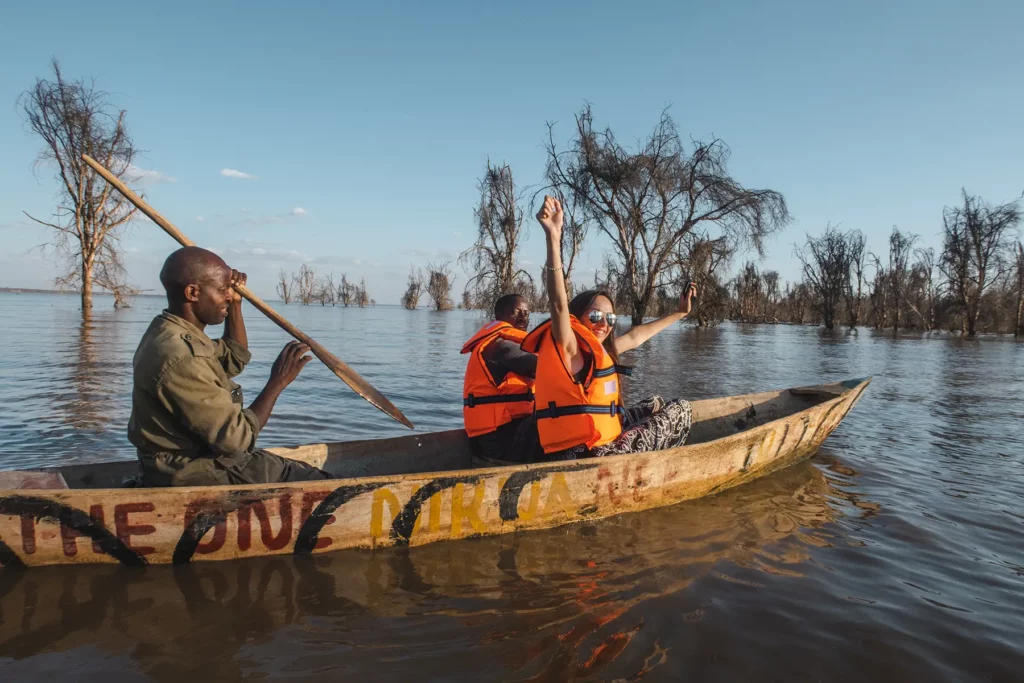
Day 5: Ngorongoro Crater & Maasai Boma (total drive time 4.5 hrs)
First thing in the morning you’ll begin your exciting 2,000 meter decent into the floor of the mysterious calera that is Ngorongoro Crater. Formed millions of years ago by the collapse of a volcano, it’s one of the few remaining places where you can see endangered black rhinos in the wild.
Activities for Your Day in Ngorongoro Crater
You’ll spend the morning on a safari drive around the crater. Your best chance to see one of the 30 black rhinos is early in the morning whilst they’re in groups before they separate for the day in search of food.
After the game drive, you will ascend the crater and head over to a local Maasai boma where you can learn more about their way of life, their connection with the crater and go on a guided walk around the rim of the crater which provides epic views.
About Ngorongoro Crater
The crater is the jewel of the larger Ngorongoro Conservation area which is a UNESCO world heritage site. Formed by the collapse of a volcano it’s actually the largest largest inactive caldera in the world! The crater floor covers about 250 km² and the crater is about 600 meters deep.
The best time to visit Ngorongoro Crater is all year round as most of the animals stay in the crater and don’t migrate. Different times of year provide different highlights such as baby animals in January and February. The long dry season from June to October provides the best visibility, due to low vegetation, to see as many animals as possible.
Tips for visiting Ngorongoro Crater
Make sure to arrange with your safari company to have a lunch prepared to eat at the side of Lake Magadi within the crater. This will usually be cooked by either your personal chef or the accommodation’s chefs. It’s an incredible experience to have a delicious lunch in such an epic environment with a vast array of animals around you, although you do have to watch out for the cheeky black kites who try to steal food.
My Personal Experience in Ngorongoro Crater
Visiting Ngorongoro Crater was one of the highlights of my trip to Tanzania. There is something incredibly magical and mysterious about the crater and as a cat lover I was delighted to have some rare daytime sightings of a serval cat hunting in the grasslands.
Another personal highlight was spotting a marabou stork skulking around the picnic site. The bird looked like something out of Jurassic Park and was the size of a human!
You can watch a video of my Ngorongoro Crater Safari experience on Youtube
Where to Spend the Night
You’ll drive to back to Arusha which takes around 4 hours, where you’ll spend the night.
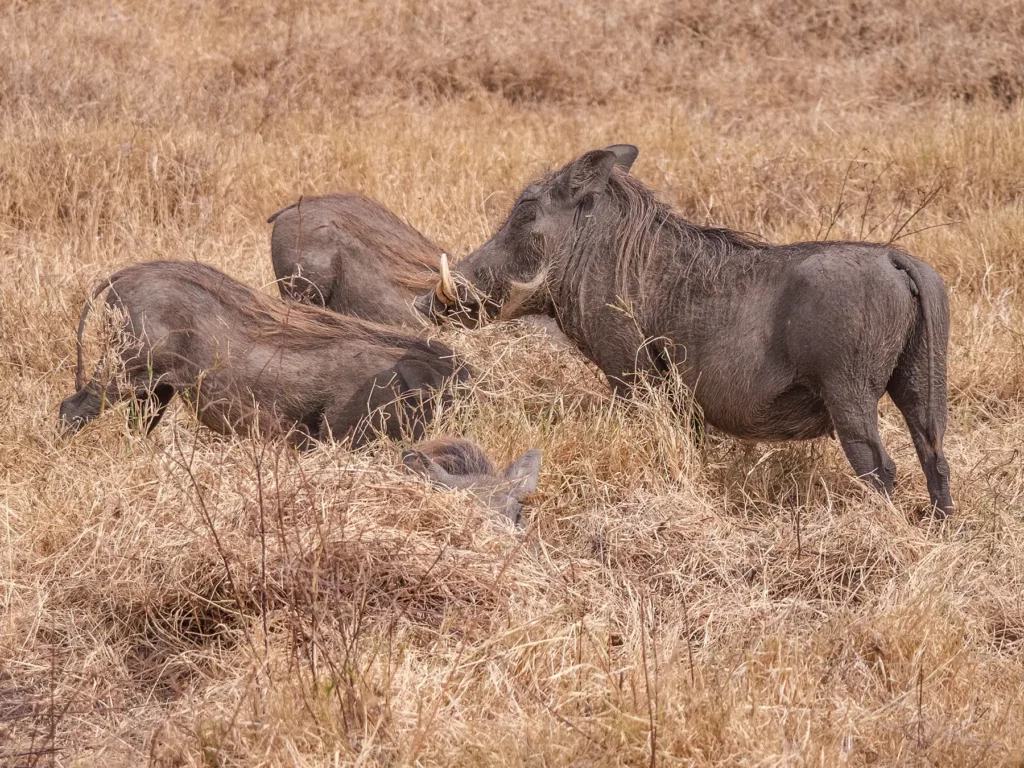
Costs
For this 5 day itinerary, full board Tanzania safari costs for private safaris start at around $250 per person per day for 4 people and $280 for two people. Prices assume working with a small local safari company and will vary depending on the level of accommodation chosen and number of people sharing the safari truck.
Recommended Booking Options For Your Budget Safari Itinerary
Private Safari
Most popular & best experience – typical prices for this itinerary start from $250 per person per day.
Visit safarisbyella.com for free quotes from trustworthy local tour companies I use to book my own trips.

Jump back to the table of contents to select another 5 day itinerary to view or keep scrolling to read the next itinerary.
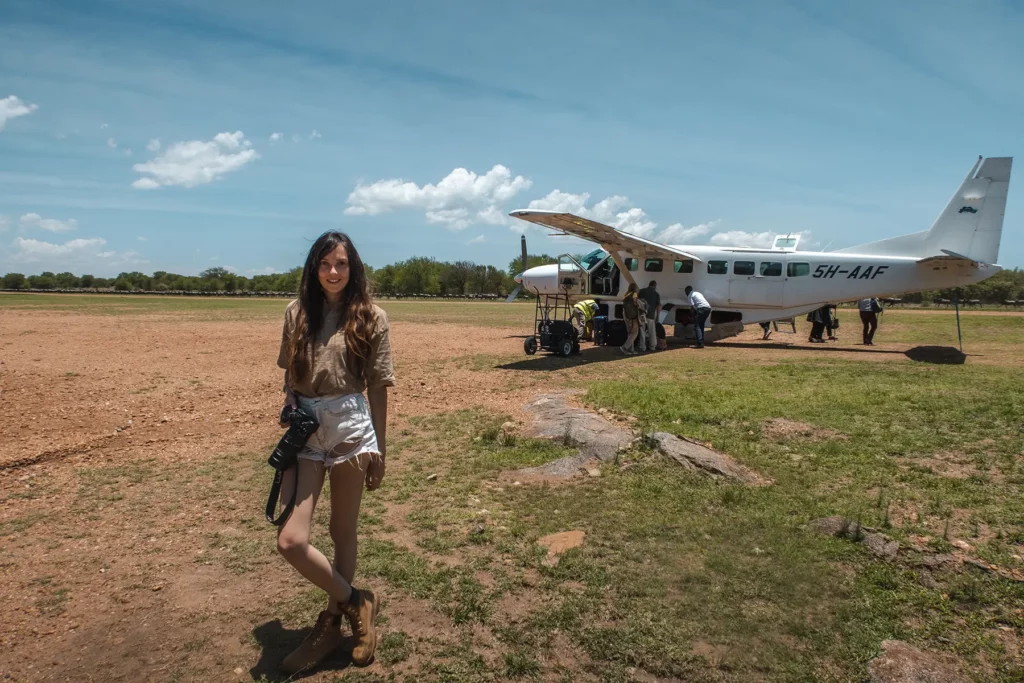
Option 5
5 Day Luxury Fly-in Safari & Beach Itinerary
If you’ve got a chunky budget and fancy a fast-paced holiday, combining the excitement and exhilaration of safari with peace and relaxation of a paradise beach destination, then this 5 day fly-in safari and beach itinerary could be just up your street.
Due to time constrains, you’ll fly to Serengeti and Ngorongoro Crater, to experience the best safari experience that Tanzania has to offer in just 3 days, followed by a direct internal flight to the tropical island of Zanzibar off the east coast of Tanzania, where you can relax and unwind.
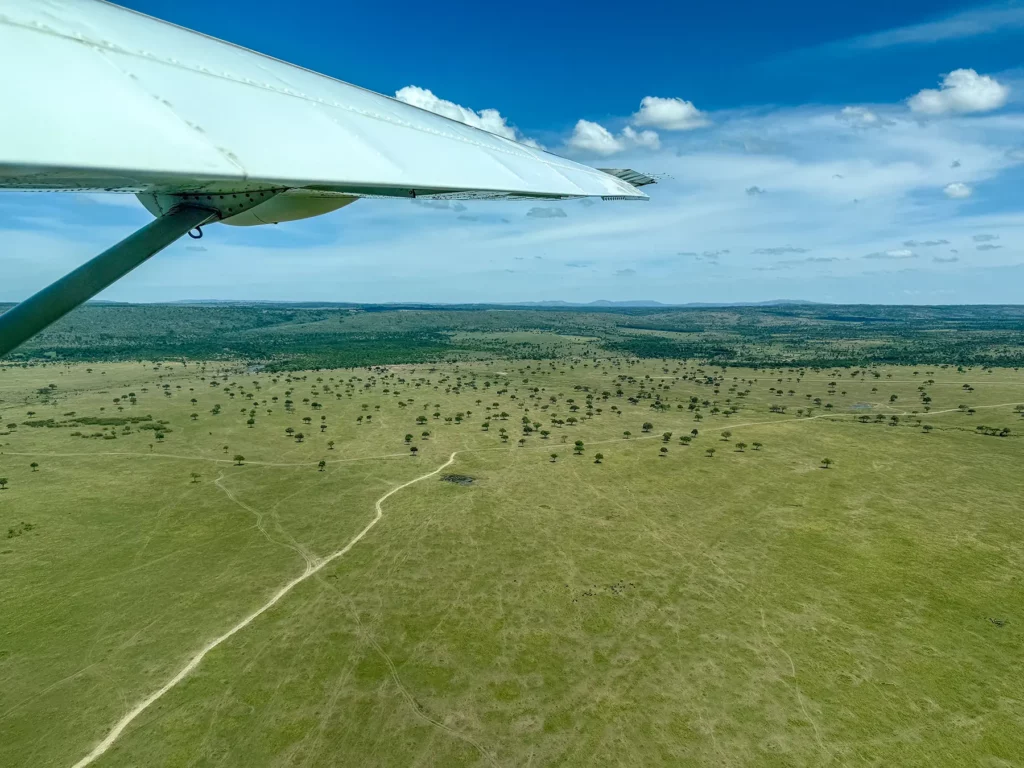
Your adventure begins with a flight on a small propeller plain from Arusha to the Serengeti.
Depending on the time of your trip, you’ll visit a different part of the Serengeti to view the Great Migration, one of the greatest wildlife spectacles on earth. I’ve covered the different locations in the day 1 – 2 summery in the day by day breakdown below.
At the end of the second day, you’ll fly to the mystical Ngorongoro crater where you will spend the night on the crater rim with glorious views of the crater floor. The following day you’ll embark on an early morning safari inside the magical crater as well as a enjoy a walking tour along the rim, led by a local Maasai guide.
If you want to make the safari more leisurely, you could spend 3 days in Serengeti but the Ngorongoro Crater is a fantastic experience if you don’t mind a 1 hour flight followed by a 2 hour drive to reach it.
Finally, you’ll fly directly to Zanzibar for 2 days of relaxation by the crystal clear ocean and white sandy beaches. Snorkelling, driving and water-sports are on the cards for many months of the year.
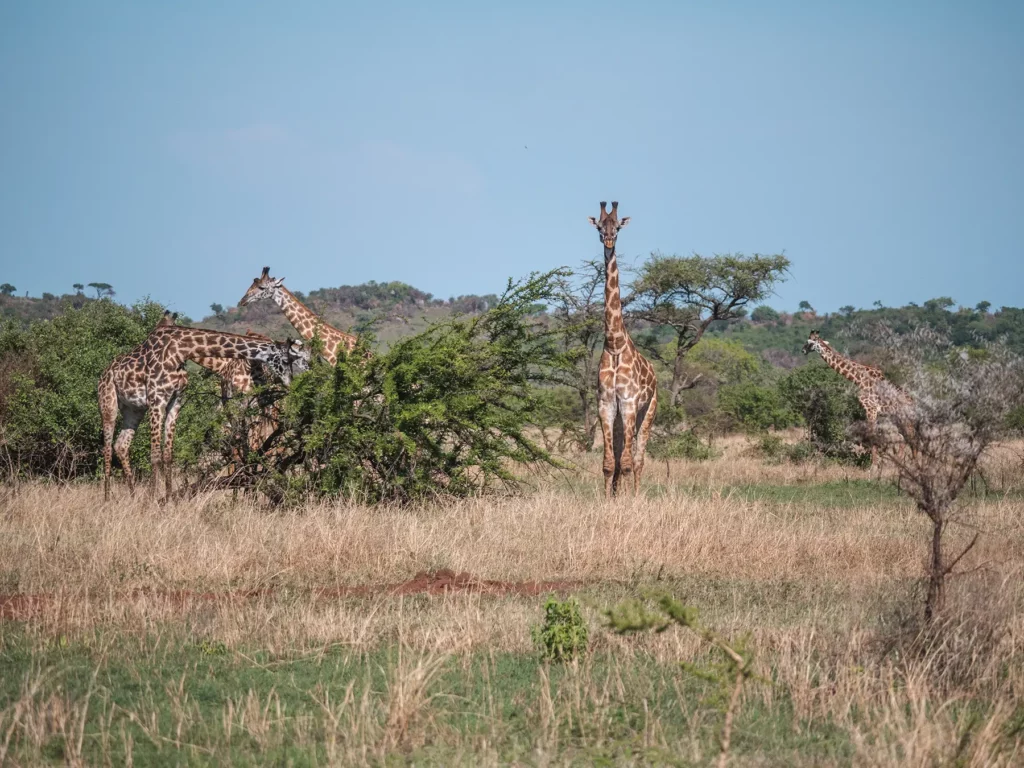
Quick Facts
- Average driving time per day: 1 hour.
- Best times of year: Long dry season from June to October or the short dry season from January to February.
Itinerary Map for 5 Day Luxury Fly-in Safari & Beach
Itinerary starts and ends in Arusha.
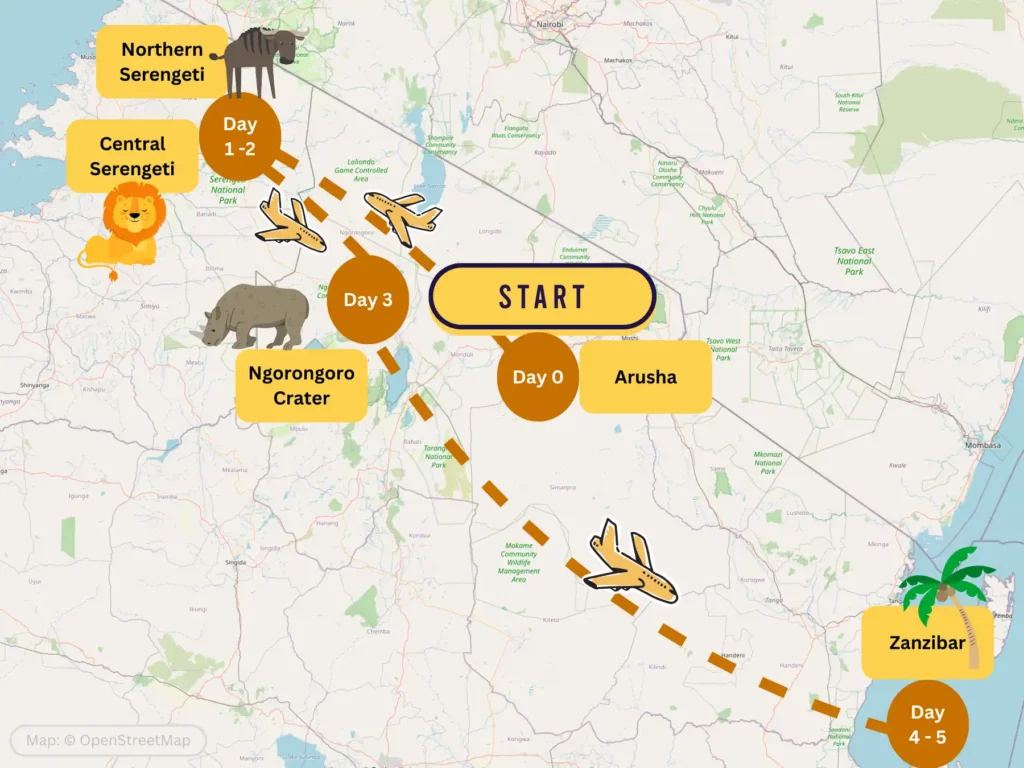
Day by Day Breakdown for the 5 Day Luxury Fly-in Safari & Beach Itinerary
Day 1 & 2: Serengeti (Exact part depends of time of year) – Total drive time: 0.5 hours
You’ll fly from Arusha to the part of the Serengeti where the Great Wildebeest Migration is currently residing, which will depend on the time of year.
If you’re visiting from mid-July to late-September or mid-October to mid-November then you’ll fly to Kogatende (northern Serengeti) to observe the pinnacle of the Great Migration – the Mara River crossing, where thousands of wildebeest at a time cross the crocodile-infested Mara River.
Between January to March you’ll fly to Ndutu (southern Serengeti) to view the wildebeest calving and related big cat activity.
Between May to July you’ll fly to the Tanzania’s Western Corridor (west Serengeti) to watch the Grumeti River crossing.
The best time to visit the Serengeti depends on which of these incredible spectacles you’d most like to experience.
Activities for Your Day in Serengeti National Park
A balloon safari is a fantastic way to see the Great Migration from above and to fully appreciate the vast scale of the Serengeti.
You’ll go on full-day game drives to view the Great Migration and the Serengeti’s other famous residents.
About Serengeti National Park
One of the greatest safari destinations on earth, the word Serengeti means ‘endless plains’ in the local Maasai language and its easy to see how the park got its name, the vast never-ending savannah melting into the horizon. To put the scale of the Serengeti in to perspective, the park is 30,000 km² size, which makes it 20 x the size of the adjoining Maasai Mara National Park.
The park is home to all of the Big Five including tree-climbing lions and, of course, the Great Migration for much of the year.
Tips for visiting Serengeti National Park
Early mornings are a great time to see predators hunting before the heat of the day encourages them to spend their time resting. Evenings are a good time too.
My Personal Experience in Serengeti National Park
You can watch a video of my Serengeti Mara River Crossing Safari experience on YouTube and my Central Serengeti safari experience.
Where to Spend the Night
You’ll spend the first night in the Serengeti and at the end of the second day you’ll fly to Manyara Air Strip which is around a 2 hour drive from Ngorongoro Crater, where you will spend the night. Ndutu Airstrip is another option but it’s a slightly longer 2.5 hours drive to the crater.
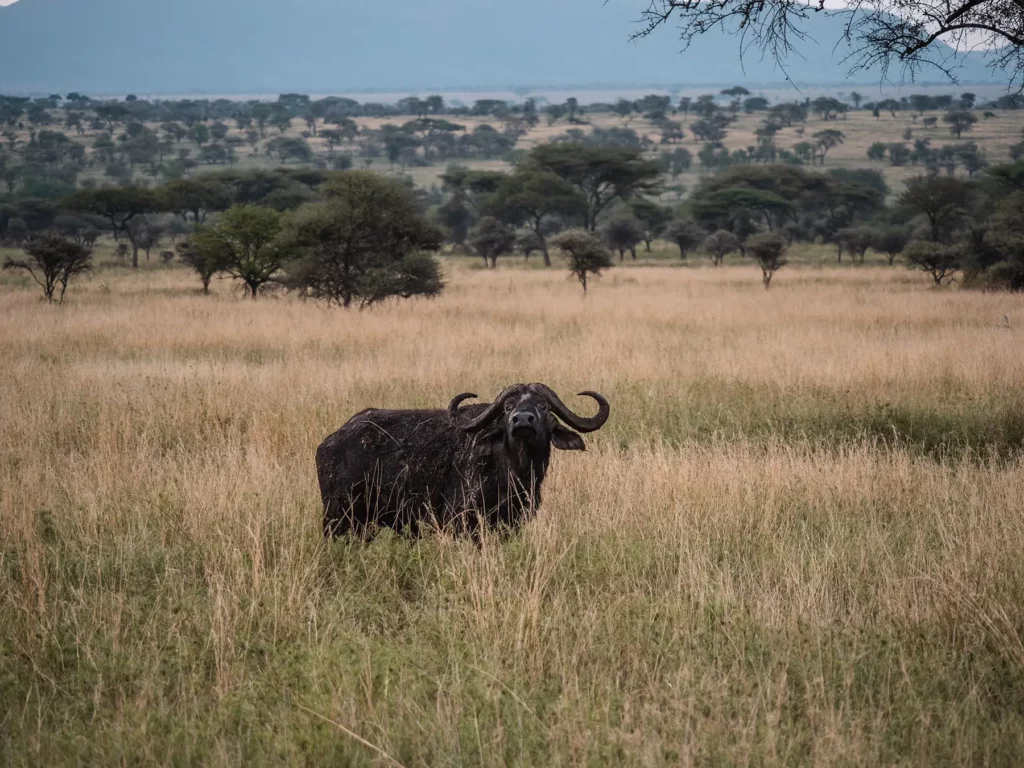
Day 3: Ngorongoro Crater (total drive time 2.5 hrs)
Visiting the crater first thing is ideal to miss the crowds and to maximise your chances of seeing one of the 30 endangered black rhinos which inhabit the crater – they usually congregate first thing before separating to search for food.
It’s a dramatic 2,000 metre descent into the massive caldera towards the crater floor.
Activities for Your Day in Ngorongoro Crater
You’ll go on a game drive through the crater and stop for lunch on the banks of Lake Magadi.
About Ngorongoro Crater
Ngorongoro Crater sits within the larger Ngorongoro Conservation area which is a UNESCO world heritage site. Other parts of the conservation area include the remote forest covered Ngorongoro Highlands to the north of the crater.
The crater was named by the Maasai Tribe after the sound produced by the cowbell (ngoro ngoro) as their crows walked around the crater.
Ngorongoro Conservation Area is the only park in Tanzania which both protects wildlife and the local population – the Maasai tribe. The two live harmoniously, side by side.
Tips for visiting Ngorongoro Crater
For night two, stay in accommodation near the crater rim which will give fantastic views over the crater and allow for an early start on day three.
You can’t beat having a pre-prepared hot lunch on the banks of Lake Magadi inside the crater. You’ll have views of flocks of lesser flamingos and the odd prehistoric looking marabou stork.
My Personal Experience in Ngorongoro Crater
Paying a visit to Ngorongoro Crater is in my opinion a must if you are going on safari in Tanzania. There’s simply nowhere like it on earth! The scenery is unrivalled and the density of wildlife that call the crater home is something to behold. You have the potential to spot all of the Big Five here.
You can watch a video of my Ngorongoro Crater Safari experience on Youtube
Where to Spend the Night
Fly from Manyara airstrip to Zanzibar after your safari and spend the night in Zanzibar.
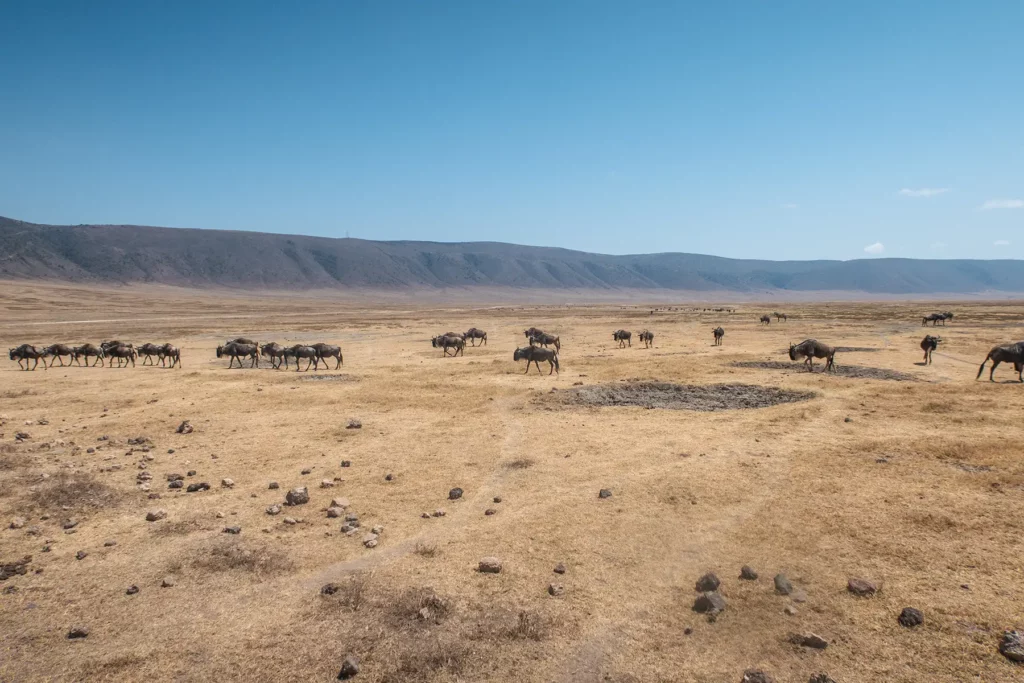
Day 4 & 5: Zanzibar (total drive time 0 hrs)
You’ll spend your last two days relaxing in Zanzibar and then you can fly from Zanzibar airport back home.
Activities for Your Day in Zanzibar
As well as relaxing by the pool or sunbathing on the beach, Zanzibar offers plenty to do.
You can explore Stone Town, a UNESCO World Heritage Centre and a melting pot of cultures from Africa, the Arab region, India, and Europe. It is this peaceful coexistence of cultures which has lead to Zanzibar’s fame for serving some of the best food in Africa – you can try the food for yourself at the local restaurants.
If you’d like to try your hand at the local cooking style, your safari company can arrange a cooking class with a local family.
Zanzibar offers world-class snorkelling and diving as well as surfing and kite surfing.

About Zanzibar
Zanzibar is an exotic archipelago made up of over 50 islands and islets, located off the east coast of Tanzania. As it’s part of Tanzania, there’s no need to go through passport control when visiting after your safari.
The two main islands are Zanzibar Island (aka Unguja) which is the largest island, and Pemba, located to the north.
There is a slave monument which remembers Zanzibar’s dark past as a hub for the slave trade. You can visit the old slave market and the house of David Livingston who was famous for abolishing the slave trade.
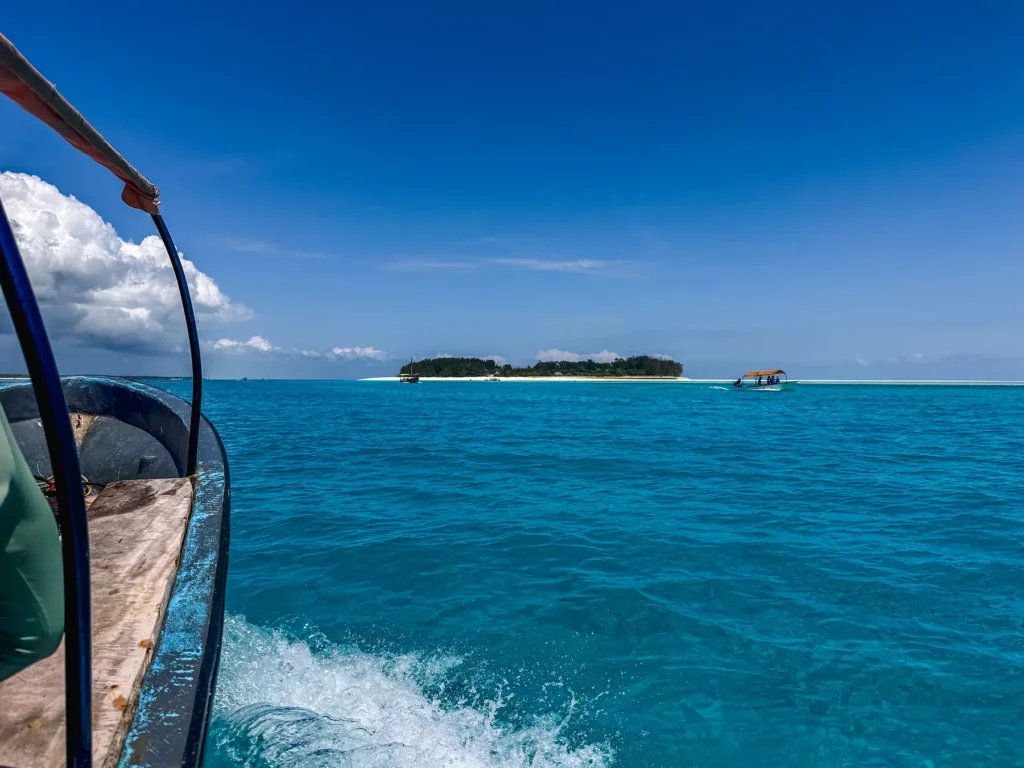
Tips for visiting Zanzibar
Zanzibar is predominantly Muslim so when in public areas such as Stone Town, it’s best to dress modestly and ask for permission before photographing people.
As with the rest of Africa, I’d recommend sticking to lower risk foods and avoiding buffets where the food has been left out.
Where to Spend the Night
You’ll spend both nights in Zanzibar.
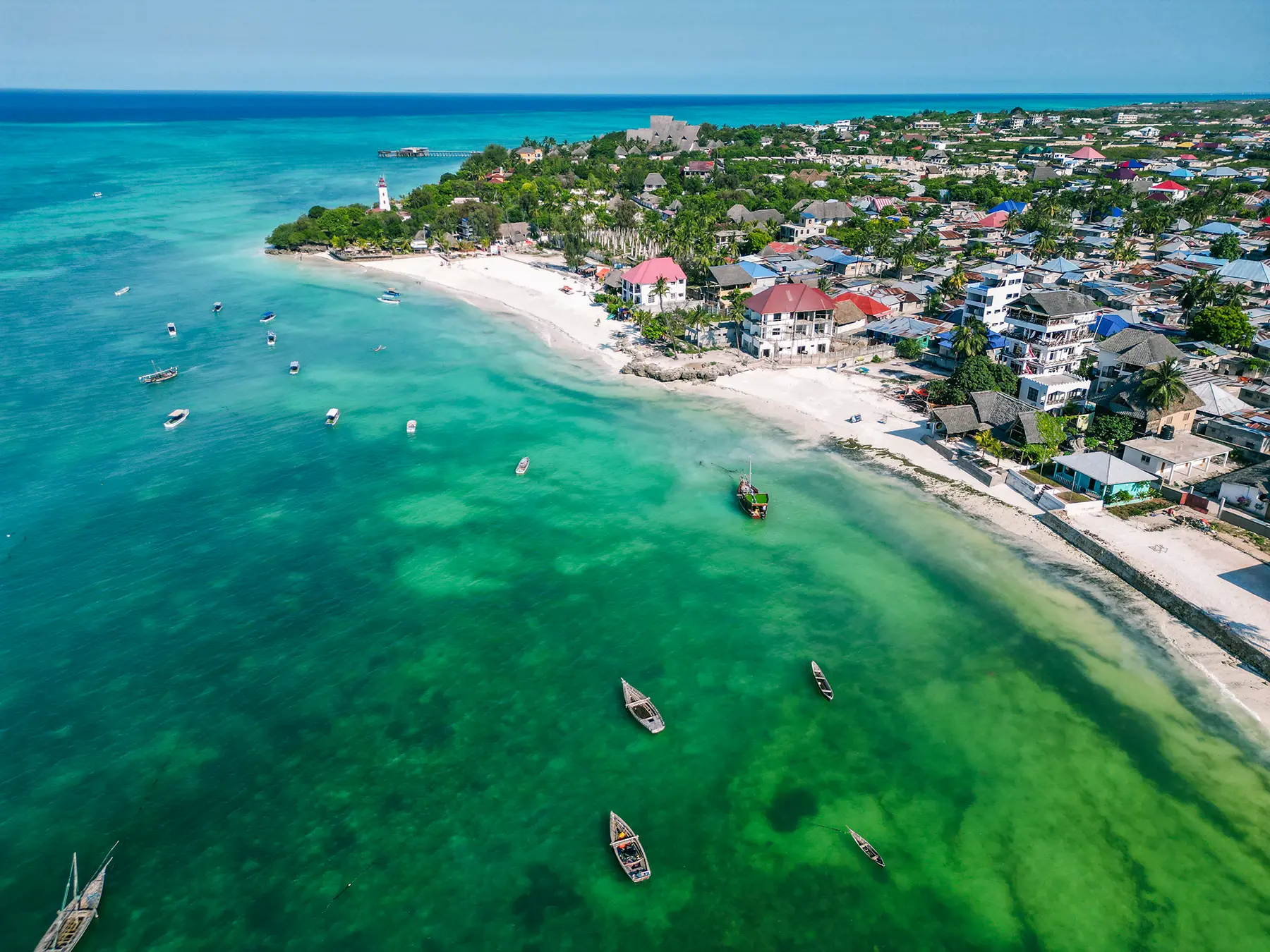
Costs
This probably going to be the most expensive of the 5 day safari itineraries due to 3 internal flights costing around $350 per flight per person. However, you’re maximising your game viewing time by minimising drive-time and packing a lot into a 5 day itinerary.
For this 5 day itinerary, full board Tanzania safari costs for private safaris start at around $600 per person per day for 4 people and $650 for two people. Prices assume working with a small local safari company and will vary depending on the level of accommodation chosen and the number of people sharing the safari truck.
Recommended Booking Options For Your Luxury Fly-in Safari & Beach Itinerary
Private Safari
Most popular & best experience – typical prices for this itinerary start from $600 per person per day.
Visit safarisbyella.com for free quotes from trustworthy local tour companies I use to book my own trips.

Jump back to the table of contents to select another 5 day itinerary to view or keep scrolling to read the next itinerary.
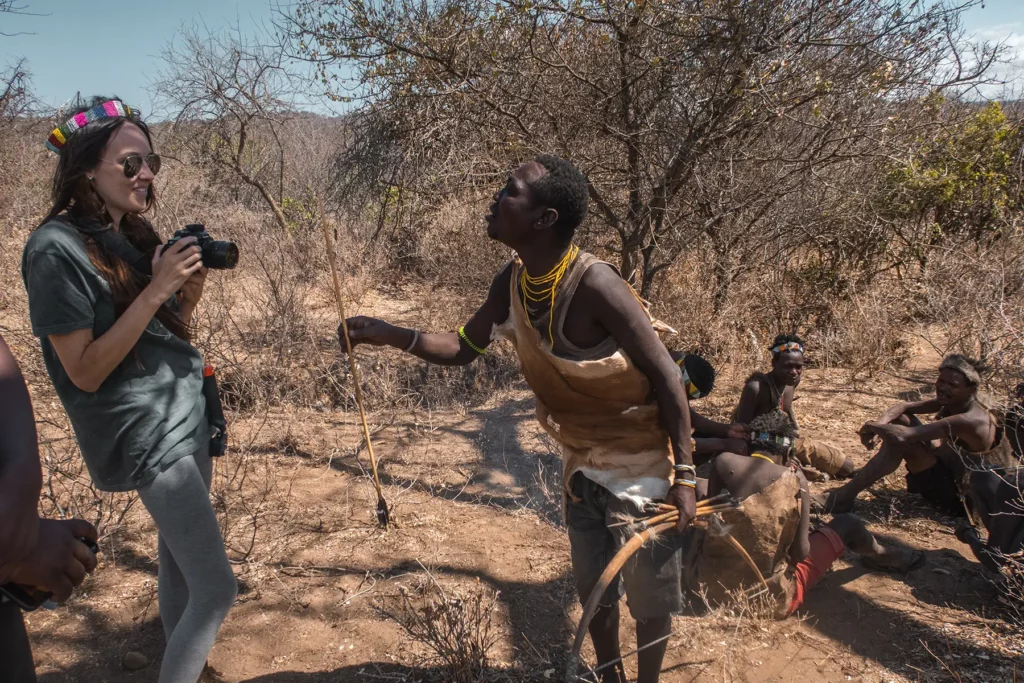
Option 6
5 Day Cultural Tour Itinerary
This 5 day itinerary aims to give you a taste of Tanzania’s rich culture by visiting 4 of their most fascinating and unique tribes: the Maasai, Hadzabe, Datoga and Chagga.
I think sometimes Tanzania’s culture gets overlooked in favour of safari. However one of my favourite experiences in Tanzania was a cultural experience, going hunting with the Hadzabe hunter-gatherer tribe.
Home to over 120 tribes, Tanzania boasts an incredibly diverse culture. The most famous tribe in Tanzania is the pastoral Maasai, known as the cowboys of Tanzania, recognisable by their distinctive dress and famous jumping dance. However, possibly even more spectacular are the lesser-known and illusive Hadzabe (sometimes known as Hazda) hunter-gatherer tribe.
The Hadzabe date back to somewhere between 5,000 and 10,000 years and talk in a unique clicking language. They maintain an authentic and untouched way of life, gathering berries, hunting for food with bows and arrows and finding their water in the roots of plants.
The Hadzabe can only be accessed via specialist guides who have lived with the tribe for at least 6 months to learn enough of their language to communicate with them and build their trust.
I’ve kept this itinerary focused on culture. However you could easily add in a safari in Arusha National Park, Tarangire National Park or Ngorongoro Crater.
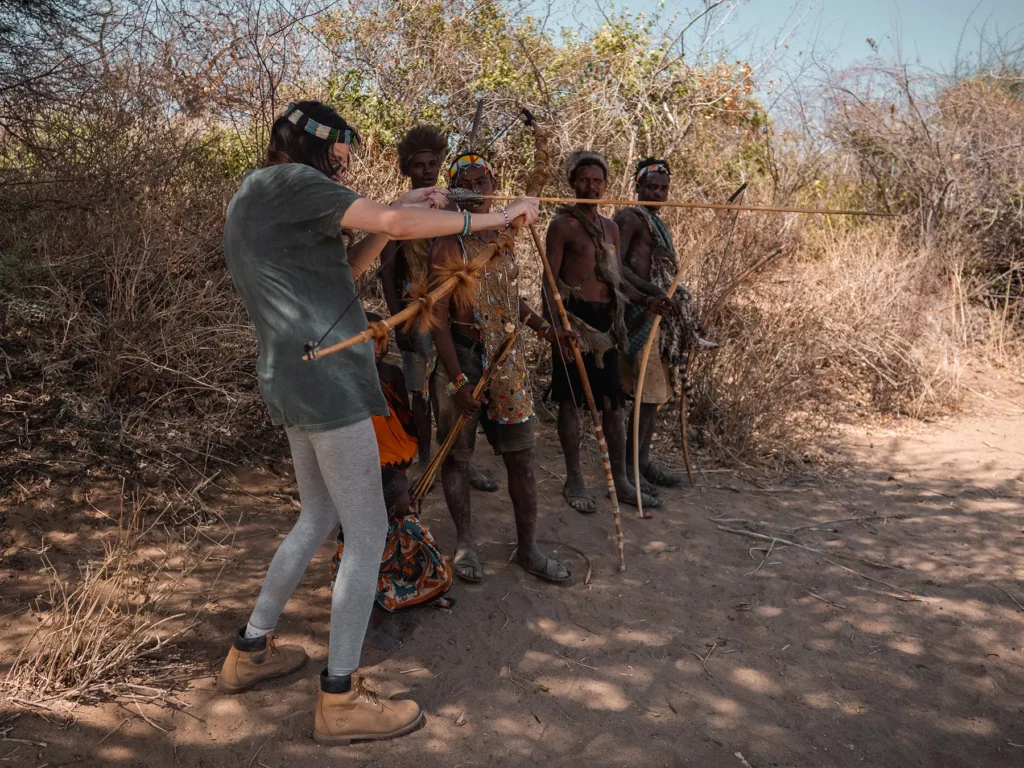
Quick Facts
- Average driving time per day: 2.5 hours.
- Best times of year: Long dry season from June to October or the short dry season from January to February.
Itinerary Map for 5 Day Cultural Tour
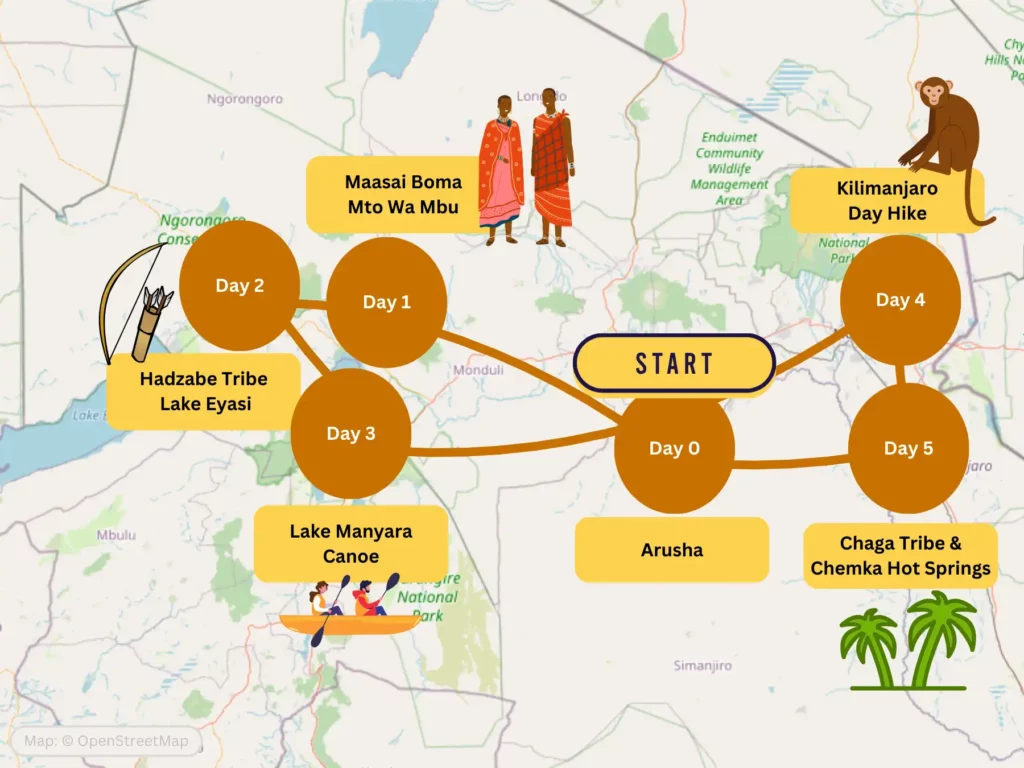
Day by Day Breakdown for the 5 Day Cultural Tour Including Hadzabe Bushmen Itinerary
Day 1: Maasai Boma in Mto Wa Mbu (Total drive time 4 hrs)
Your trip starts off with a 2 hour drive to from Arusha to Mto Wa Mbu which means ‘River of Mosquitos’ in Swahili or as the locals call it ‘Mosquito Town’.
I actually forgot my mosquito spray when I arrived and shortly found out where the town got its name from! It’s hot and humid with lots of still water from the rice farming – mosquito heaven! Luckily a local gave me a bar of natural mosquito repellent and I rubbed it all over and after that, I didn’t get a single bite.
Activities for Your Day
You’ll spend the day visiting a local Maasai boma to learn about their culture and way of life.
About The Maasai tribe
The Maasai are famous for their vibrant clothing and jumping dance.
Originally from Sudan, the Maasai migrated to northern Tanzania in the 15th century and are renowned as fierce warriors.
They are a pastoralist tribe who place great importance on their cows. Cows are everything to them as their cows give them all they need to survive. Cows provide food, milk, blood and even act as currency. The more cows a Maasai warrior possesses, the richer and more respected he is within the tribe. Cows are also used as a gift to the father of the bride when choosing a wife (of which the Maasai usually have many).
The Maasai are very welcoming to guests and they will usually greet you by putting on a jumping dance, where the men of the village jump as high as they can, which is a sign of their strength. They accompany the dance with instruments and vocals.
During the full-day visit, your safari company will also arrange with the Maasai for them to provide other activities such as a tour of the boma (village), including looking inside their houses. The Maasai will also show you how they light a fire and cook food.
Tips for visiting The Maasai tribe
I’ve visited a few different Maasai bomas in Tanzania and I’ve found that it’s important to work with a good safari company as they will take you to the right boma for a more authentic experience as some of the most regularly visited bomas have become a little commercialised and less authentic. Generally the more remote the boma, the more authentic an experience you’ll have.
After your visit the tribe will usually give you the opportunity to buy some bracelets made by the women of the tribe. Don’t feel under pressure to buy one but if you do, you can negotiate the price and I found around $20 was considered acceptable.
My Personal Experience with the Maasai tribe
I went a step further on my visit and witnessed a traditional goat slaughtering (I love animals but as a meat-eater I strongly believe we should be connected with where meat actually comes from) and watched how they prepared the meat, drank the blood for health benefits and then started and fire and cooked the meat. I ate some raw liver which was very tasty and my stomach was fine – probably because it was so fresh.
You can watch a video of my Maasai visit on YouTube or the goat experience I witnessed here.
Where to Spend the Night
After your visit, you’ll make the 2 hour drive to Lake Eyasi for the night ready for the adventure of a lifetime tomorrow.
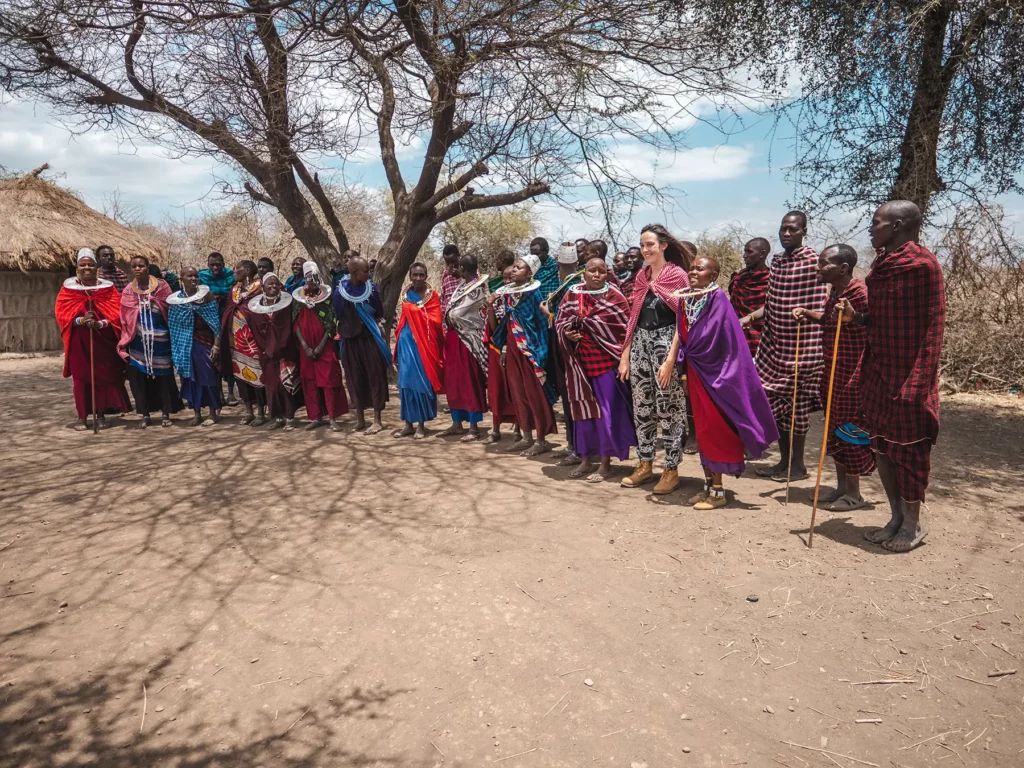
Day 2: Hadzabe & Datoga Tribes in Lake Eyasi (total drive time 2 hrs)
You’ll start early to try and locate the nomadic Hadzabe tribe before they leave for their morning hunt. Visiting the Hadzabe, also known as Hazda, was one of my favourite experiences in Tanzania. The experience felt incredibly authentic as they still live a completely traditional life, speak no English and are largely untouched by our modern lives.
Visiting the Hadzabe also gives you a glimpse of how our own ancestors would have lived back when most of civilisation was hunter-gatherers and lived a simple, uncomplicated life.
Activities for Your Day in with the Hadzabe & Datoga Tribes
You can explore the Hadzabe’s nomadic village and through your interpreter learn more about their way of life. The tribe will also put on a traditional dance and show you how they make fire and teach you some of their unique clicking language. If you’d like, they can take you on a small hunt where they will show you their incredible hunting skills with bows and arrows. Anything small they catch will be cooked and eaten on the spot whilst bigger catches will be taken back and shared with the rest of the village.
It’s also possible to go on longer hunts but this will require special arrangement in advance and you’ll need to be prepared to keep up with them as they move at a very fast speed through the bush.
After your visit with the Hadzabe, there is just time for a quick visit to the neighbouring Datoga tribe (aka the blacksmiths) with whom the Hadzabe trade in order to get their arrowheads.
During your visit, you will see their traditional dress and take a peek inside the village and traditional houses. You will also see how they melt down scrap metal using a simple furnace and craft beautiful jewellery and other items such as arrowheads.
About the Hadzabe & Datoga Tribes
The Hadzabe are one of the oldest indigenous groups in Tanzania, having inhabited the lands around Lake Eyasi for thousands of years.
They are hunter-gatherers, living in temporarily huts. Their lives revolve around hunting for meat and gathering berries and roots for water. The Hadzabe eat everything except hyenas as when a member of the tribe dies, they aren’t buried. Hyenas are notorious scavengers (you can see where this is going) therefore, for the Hadzabe, eating a hyena would be like eating their deceased relatives.
One of the first things you’ll notice is their unique clicking language. It’s beautiful to hear. The Hadzabe speak no other language (not even Swahili) so it’s necessary for your safari company to arrange for a specialist guide who has lived with the Hadzabe for over 6 months and has learned some of their language.
Their neighbours, the Datoga tribe, migrated from their original home in southern Sudan and the western Ethiopia highlands to the Lake Eyasi basin around 3,000 years ago.
Traditionally, they were nomadic pastoralists and moved around in search of grazing for their heard of cattle, goats and sheep. However, over time they have settled into permanent villages where they have become experts at ironmongery and craft arrow heads and jewellery which they trade with other tribes such as the Hadzabe.
Tips for visiting the Hadzabe & Datoga Tribes
Stay open-minded when visiting the Hadzabe as their lives are so different from out own. Their lifestyle can be raw but it’s also beautiful.
You will have the opportunity to buy some jewellery from both tribes. I couldn’t resist buying a couple of bracelets to remember my visit which I negotiated to around $35.
My Personal Experience with the Hadzabe & Datoga Tribes
I had an incredible time visiting both of these tribes. My time with the Hadzabe was the most memorable however. I arranged with my guide to go on a large hunt with the tribe and over the course of our morning, I felt like I really got to know the individual members of our hunting party and got to witness first-hand what their daily lives entail. One can’t help but admire their strength and determination. They have to go out every morning to hunt and if they don’t catch anything, that means no food for the village. It’s a struggle that we have never known and seeing it first hand is rather humbling.
You can watch a videos of my Hadzabe visit on YouTube and my visit to the Datoga Tribe on YouTube.
Where to Spend the Night
You’ll return to Mto Wa Mbu for the night which will take up to an hour.
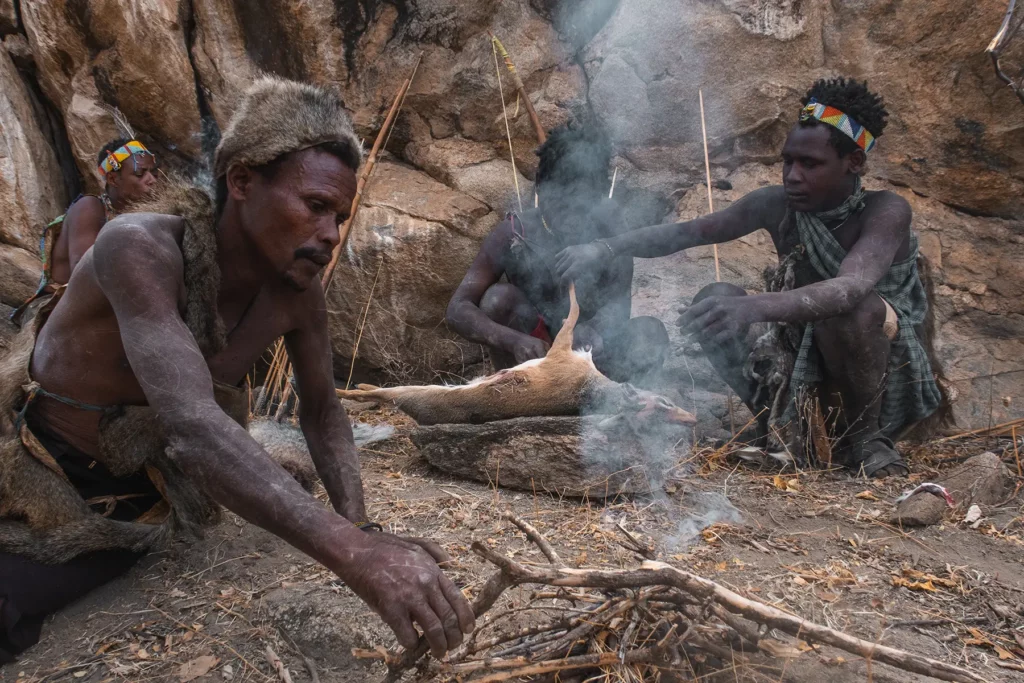
Day 3: Mto Wa Mbu Cultural Tour & Lake Manyara Canoe (total drive time 0.5 hrs)
You’ll spend the day on a cultural tour in Mto Wa Mbu, a bustling farming community located between Lake Manyara and Ngorongoro, followed by a canoe trip on Lake Manyara.
Activities for Your Day in Mto Wa Mbu & Lake Manyara
You’ll spend the morning on a cultural tour where you’ll walk round the banana plantations with 18 varieties of bananas.
You’ll also have the opportunity to buy freshly brewed coffee made from local coffee beans and see the rice paddies.
You will see the traditional houses of some of the 120 tribes that call this village home and learn how they are designed to keep cool in the day and warm at night.
In the afternoon you’ll visit Lake Manyara and where you will see how climate change has changed the lake, and how it’s affecting the local villager’s livelihoods. You’ll go on a canoe trip across the lake where you can often hear the haunting sound of hippos.
About Mto Wa Mbu & Lake Manyara
Mto Wa Mbu is Swahili for ‘River of Mosquitos’. All land here is owned by the government fairly split between all local families so that they can each grow crops to support their family. It seems like a good system as rather than land all being owned by rich landowners, each family has some land of their own.
You’ll learn how they avoid using and chemicals and instead use natural methods such as manure from Maasai lands to fertilise their soil. You can stop at an eatery within the sprawling banana plantation where there is a buffet serving traditional dishes from many of the tribes, followed by sweet red banana for dessert.
Mto Wa Mbu is built on the banks of a river to the north of Lake Manyara. This thriving town is a green oasis in a largely arid region. It’s one of the most culturally diverse regions in Africa with over 120 tribes living side by side.
Tips for visiting Mto Wa Mbu & Lake Manyara
Make sure you’re covered with mosquito repellent before visiting. I foolishly made this mistake and suffered the consequences! Thankfully, the local restaurant had some natural repellent on hand for me to use which did the trick.
My Personal Experience in Mto Wa Mbu & Lake Manyara
You can watch a video of my Lake Manyara canoe safari and Mto Wa Mbu tour on YouTube.
Where to Spend the Night
You’ll return to Arusha for the night which is a 1.5 hr drive.
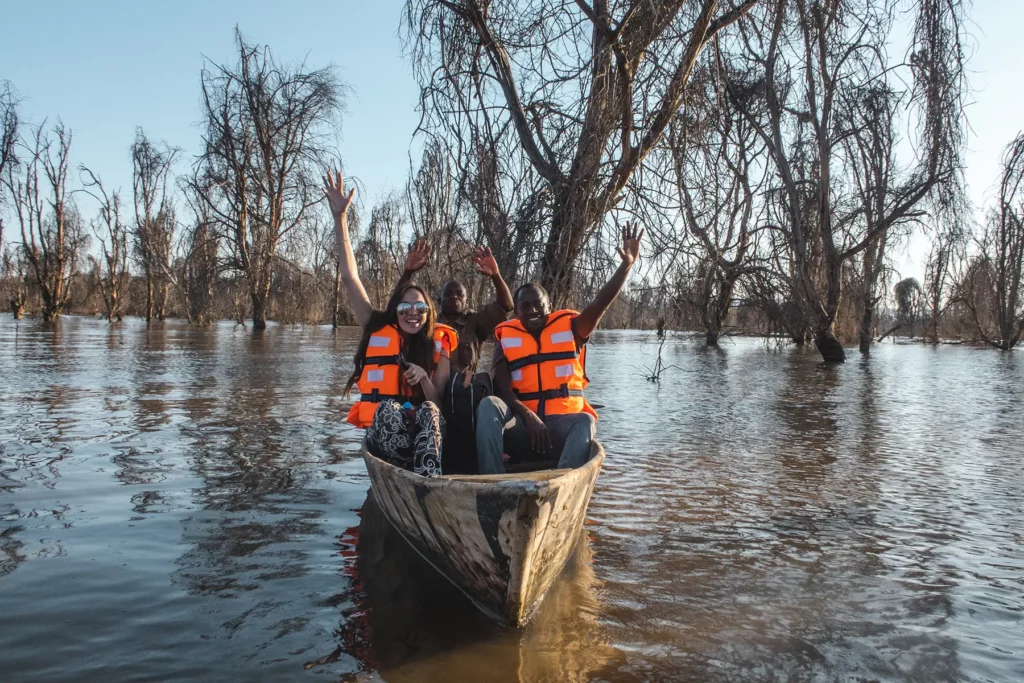
Day 4: Kilimanjaro Day Hike (total drive time 2.5 hrs)
For your Kilimanjaro day hike, my recommendation would be the Marangu Route as it has a lower starting point (Marangu Gate) compared to some other routes.
The Marangu gate is located at the south east of Kilimanjaro. From here you’ll hike to the first hut on the route which is called the Mandara Hut (2,700 meters or 8,858 feet).
It’s the oldest path and relatively gentle and can be done in a few hours.
During the initial rainforest section you might be able to spot colobus monkeys, blue monkeys and various bird species.
Activities for Your Kilimanjaro Day Hike
You’ll spend the day hiking up and down the lower sections of the mountain.
About Kilimanjaro
Mount Kilimanjaro, located in Tanzania, is the highest peak in Africa, rising approximately 5,895 meters (19,341 feet) above sea level. It’s a dormant volcano with three volcanic cones and is a popular destination for trekkers and climbers seeking to reach its snow-capped summit.
Tips for visiting Kilimanjaro for a day hike
If you fancy something a little more challenging, you might also want to consider the Lemosho route instead. It starts from the Londorossi or Lemosho gates by the Lemosho Glades on the west of Kilimanjaro.
The Lemosho route starts from a higher altitude compared the the Marangu route and offers even more wildlife spotting opportunities as it passes through a range of different ecosystems. The terrain is more challenging and there is no fixed finish point for a day hike on this route.
Where to Spend the Night
Once back at the base of Kilimanjaro, you’ll drive to your accommodation and spend the night in Moshi.
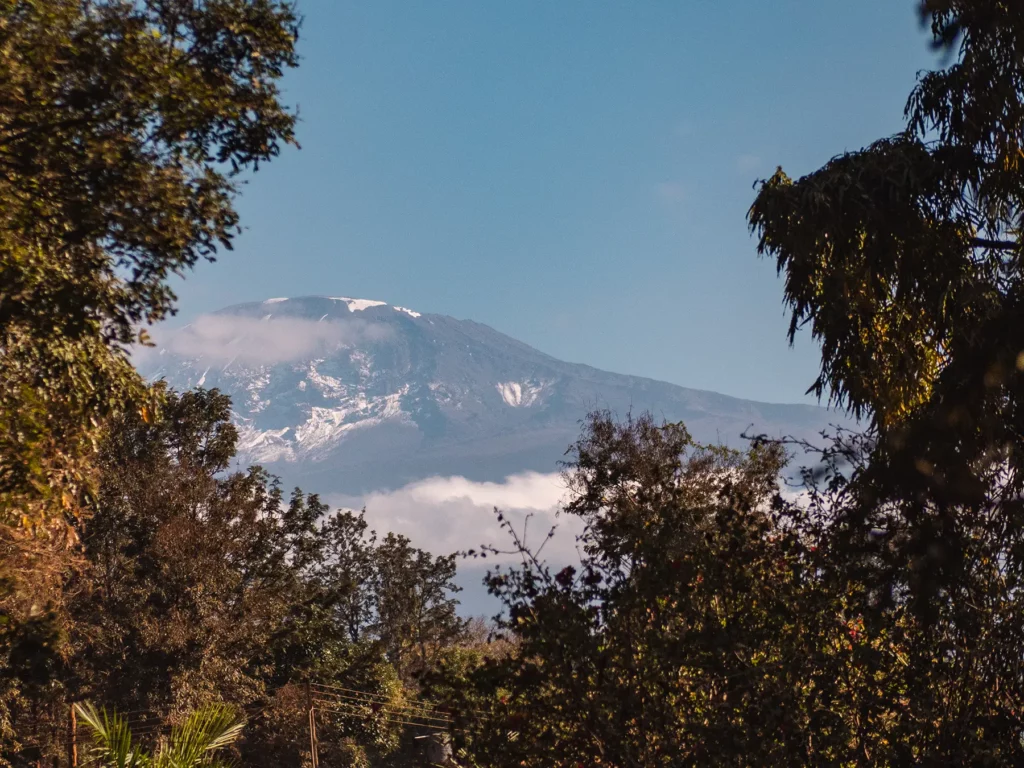
Day 5: Moshi – Chaga Tribe, Materuni Waterfalls & Chemka Hot Springs (total drive time 2 hrs)
You’ll spend the morning on the slops of Kilimanjaro, in Materuni village with the Chagga tribe and the afternoon relaxing in the Chemka Hot Springs to the south of Moshi.
It’s around 45 minutes drive from Moshi to Materuni village – the village is located on the southern slopes of Kilimajarao at an altitude of 1300 m above sea level.
Activities for Your Day in Kilimanjaro with the Chaga tribe & Chemka Hot Springs
From Materuni village, it’s a relatively easy 45 minute walk to the impressive Materuni Waterfalls where you can swim if you wish but the water is often quite cold. It’s possible to drive closer to make it a 15 minute walk if required.
From the waterfalls, the return walk is around an hour as it involves some uphill parts. You’ll arrive back for a coffee experience and Chagga lunch with the Chagga tribe in Materuni village. As part of the coffee experience, you’ll learn how the villagers grow and harvest the coffee beans and then take part in the full process of preparing and roasting the beans by hand and finally trying the delicious fresh coffee.
For the afternoon it’s a 1 – 2 hour drive down to the Chemka Hot Springs for a relaxing afternoon.
About Kilimanjaro, the Chaga tribe & Chemka Hot Springs
The Chagga (sometimes referred to as Chaga) are the third largest ethnic group in Tanzania and descended from immigrants of various Bantu tribes who inhabited the once forest-covered foothills of Kilimanjaro around 1,200 years ago.
The tribe are famous for their work ethic and members of the tribe work as porters carrying equipment up and down Kilimanjaro during expeditions. They also grow coffee amongst other crops on the fertile slopes of the mountain using organic fertilisation methods practised since the 1920s. The coffee has been a large source of income, leading to them becoming one of the wealthiest tribes in Tanzania.
The Chemka Hot Springs are geothermal springs which bubble up from the earth. The hot springs are made up of two lagoons connected by a narrow channel. At the bottom of the largest lagoon is an underwater cave which produces bubbles and this is the source of the hot springs. The water originates from Kilimanjaro and is the reason why it’s warm.
Despite what the name would suggest, the hot springs are not hot bur rather pleasant at around 20°C.
Tips for visiting Kilimanjaro, the Chagga tribe & Chemka Hot Springs
If you are not a strong swimmer, there’s the option to rent floatation devices at Chemka Hot Springs. I’d recommend this if you aren’t confident in the water as the springs are 10 meters deep at their deepest.
There is also a rope swing into the water and a restaurant with excellent local food.
If you can, bring a snorkel mask as it’s very pretty underwater.
My Personal Experience in Kilimanjaro, the Chaga tribe & Chemka Hot Springs
You can watch a video of my Chemka Hot Springs experience on YouTube.
Where to Spend the Night
You’ll head back to Arusha for the night.

Costs
This is the lowest cost of the 5 day itineraries due the the fact that park fees are a big percentage of safari costs and this itinerary only requires minimal park fees.
For this 5 day itinerary, full board Tanzania safari costs for private safaris start at around $230 per person per day for 4 people and $260 for two people. Prices assume working with a small local safari company and will vary depending on the level of accommodation chosen and number of people sharing the safari truck.
Recommended Booking Options For Your Cultural Tour Including Hadzabe Bushmen Itinerary
Private Safari
Most popular & best experience – typical prices for this itinerary start from $230 per person per day.
Visit safarisbyella.com for free quotes from trustworthy local tour companies I use to book my own trips.

Jump back to the table of contents to select another 5 day itinerary to view.
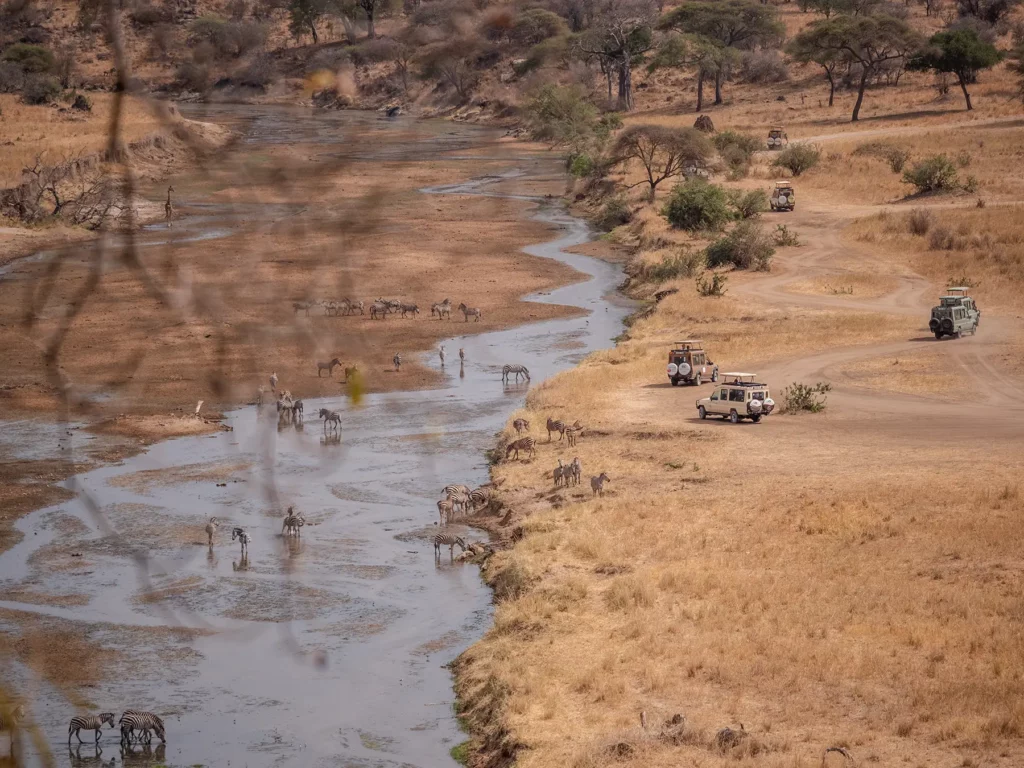
Is 5 Days Enough in Tanzania?
Yes – 5 days is enough time to visit all the most popular safari parks in Tanzania’s northern circuit. In this guide you can find six unique 5 day Tanzania itineraries.
Whilst 5 days is enough time, a 7 – 10 day Tanzania itinerary would be the optimum amount of time if you want to really immerse yourself in the wildlife and culture of the country.
For Tanzania’s famous safari and beach combination, you would need to travel internally via small propeller planes to fit both safari and beach (Zanzibar) into a 5 day itinerary.
If you wanted to incorporate Tanzania and Kenya in your safari, whilst that’s technically possible in 5 days, you would ideally need 7 – 10 days to visit both countries.
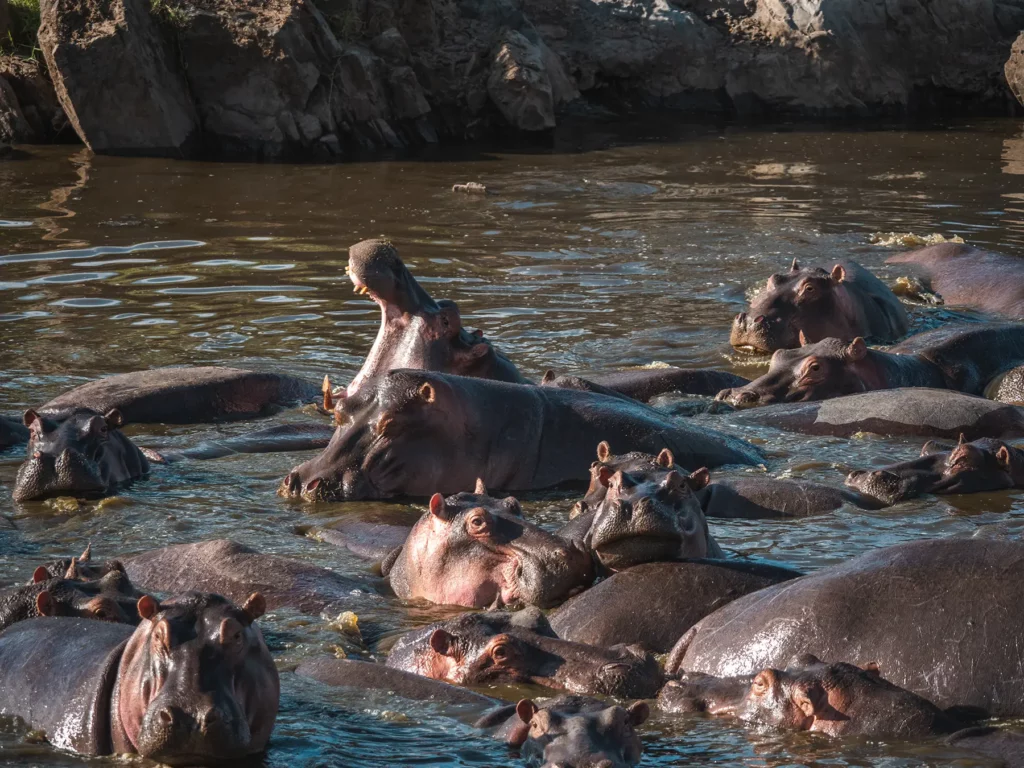
How to Book a 5 day Safari Itinerary in Tanzania?
In my experience the best way to book a safari in Tanzania is to use a safari company who will organise your whole safari for you, including accommodation. The country is very much geared-up to using safari companies as, compared to other countries, there are a lot of pitfalls when trying to organise it yourself.
In Tanzania, I always use a local safari company to organise my whole trip including full board accommodation, game drives, excursions, internal flights etc. I do, however, book my own international flights.
Safari companies generally fall into the following groups:
Local Tanzania Safari Companies
Local safari companies are typically run by locals and offer the best value for money.
I always prefer to use smaller up-and-coming local tour companies as I find it gives me the best experience, it supports the local economy and gives me the best value for money. They usually get discounts on the hotels so it works out pretty cost-effective and saves me a lot of hassle. I also find it gives me the most personalised service.
You can get quotes from the local tour companies I use to book my own trips on safarisbyella.com
International Travel Agents
International Travel Agents based in your own country are more expensive and they typically out-source the safari to a local safari company anyway. They have the benefit of being able to book international flights and provide ATOL protection (in the UK). However, I usually find that my travel insurance and paying deposits via credit card gives me similar protection when booking direct.
In addition to deciding which type of tour operator to use, you also have a choice of both private and group safaris.
Private vs Group Tanzania 5 day Safaris
Private Tanzania safaris are the most popular option as they are completely customisable, giving you full flexibility.
With a private safari you have your own driver / guide and your own safari truck. You can specify your exact itinerary as well as the start and end date. Private safari typically have the best and most experienced guides and provide the ultimate experience.
You can request quotes for private safaris from the local tour operators I use on safarisbyella.com
Group / Shared Tanzania Safaris run to a set itinerary and begin at pre-set times. You are essentially joining a pre-scheduled tour and will share the safari truck with other people on the same tour. Group safaris usually run for 3 or 6 days.
Group safaris could be worth consideration if you are travelling solo (which makes private more expensive as the car / drive / guides costs are not being split by other people in your group) or don’t have the budget for a private safari. However, group safaris are usually aimed at the budget market and accommodation can be very basic tents with shared wash facilities and less experienced guides.
The feedback I’ve had from people who’ve tried both private and shared safaris has been that their private safari experience was much better.
If you’d like to consider a group safari, you can jump to my recommended group safaris.
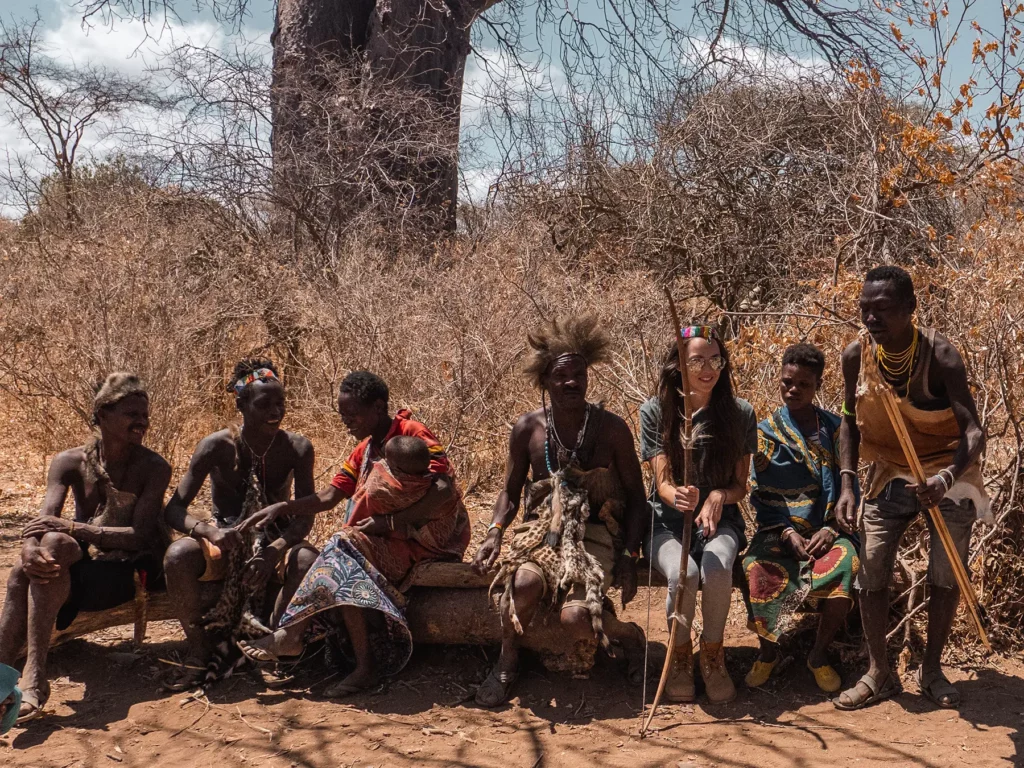
How Much Does a 5 day Tanzania Safari Itinerary Cost?
For a budget private safaris with four adults in shoulder season such as January, the costs start from $250 per person per day (full board but excluding external flights, visas, tips, alcohol) so that would equate to $1,000 per person for a 5 day safari.
For a budget private safari with two adults sharing a safari truck in high season, prices start at around $350 per person per day (full board but excluding external flights, visas, tips, alcohol) so for a 5 day safari prices would start at $1,750 per person.
For a mid-range private safari for two adults in high season prices start at around $450 per person per day which equates to $2,250 for the 5 days.
For more information, see my guide on Tanzania safari costs.
Tanzania Safari Tips & Tricks – Avoiding my Mistakes
1. Flights usually arrive late – I would strongly recommend that you arrange for your safari company to pick you up in their safari truck or use a high-end taxi service. As with most African countries, driving at night is best minimised as drivers often go over the speed limit due to lower police presence at night and visibility is often poor. You can read about how I learn this the hard way here.
2. Make sure to choose a safari company who you feel really cares about your trip and who can offer a very personalised experience – not just the cheapest. You going to be spending a lot of time with the companies’ driver / guide and working with a great safari company can make the difference between the experience of lifetime and an a not-so-great experience.
3. Don’t wear black or navy blue clothing on safari as it will attract tsetse flies. If possible wear typical safari colours such as beiges and greens.
4. To see the most wildlife include some game drives at dawn or dusk.
5. Wear multiple layers as it can get very cold in the evenings but very hot during the day.
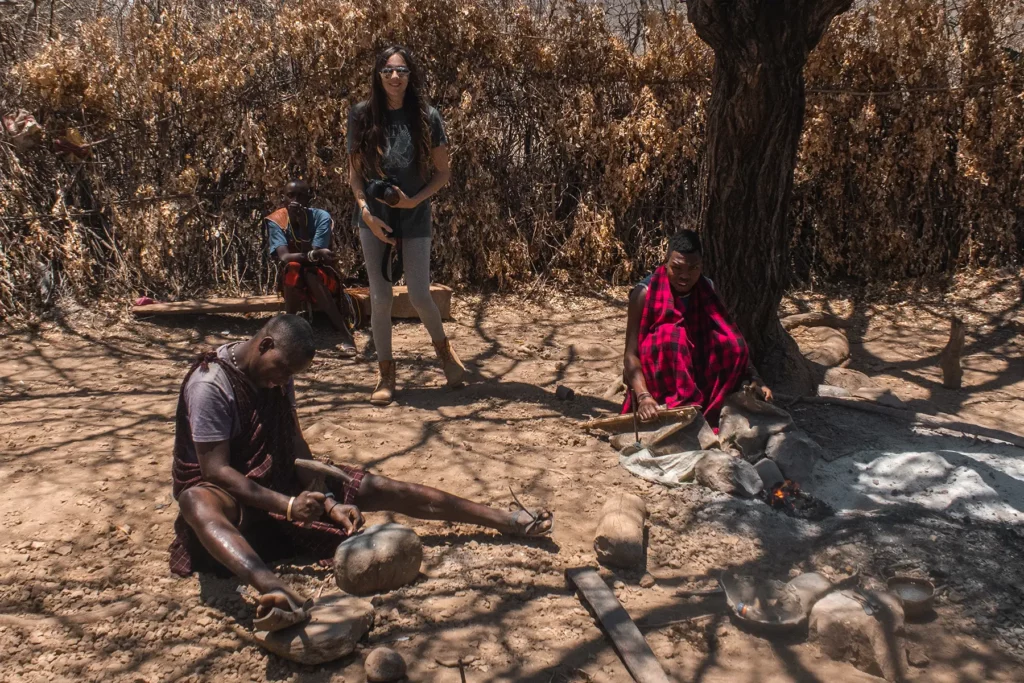
Read More Tanzania Guides
For an overview of planning your safari, you can read my Ultimate Tanzania Safari Guide.
Tanzania Itineraries
Recomended itineraries and how to book them.
7-10 Day Tanzania Safari Itinerary & Costs
5-Day Tanzania Safari Itineraries & Costs (6 unique Itineraries)
3-Day Tanzania Safari Itinerary & Costs
2-Week Tanzania & Zanzibar Safari Itinerary & Costs
3-Week Tanzania Safari Itinerary & Costs
10-Day Tanzania Honeymoon Itinerary & Costs
Tanzania and Kenya Itineraries
Multi-country itineraries and how to book them.
10-Day Kenya and Tanzania Safari Itinerary
2-Week Kenya & Tanzania Safari Itinerary
Costs & Planning
How to get the most bang for your buck and the best time of year to visit depending on what you want to do and see.
Tanzania Safari Cost – Everything You Need to Know!
The Great Wildebeest Migration Guide
Zanzibar Island – The Complete Guide
National Parks & Reserves
Complete guides to the best and most famous safari reserves, including the wildlife you’ll see, entrance costs and best time to visit.
Other Popular Safari Destinations
How to Book Your Safari
Save time and ensure an incredible safari experience by getting quotes from my recommended local safari companies.
Join the rapidly growing tribe of over 1,000 travellers who’ve booked their dream safari using my insider tips and recommendations.
